Shaping Possibilities



Sponsored by






Sponsored by


Our daily lives are hugely impacted by our travel experiences, writes Minister for Transport Eamon Ryan TD.
Having a bad journey or getting caught up in traffic can affect your mood, your productivity, your social life, and your health. The Climate Action Plan sets targets to reduce transport emissions, but there are so many other reasons for wanting to improve our transport system and to make it more efficient for everyone.
In recent decades, and as in most other countries, the car and road-based freight have become the dominant means for moving people and goods within Ireland. Through urban planning and road-building programmes, we supported this trend by allocating more and more of our public and civic spaces to cars, vans and trucks.
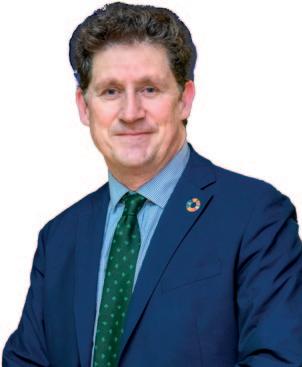
Congestion does not work for anyone
In hindsight, knowing what we know now, I think we may have adopted a different approach to supporting mobility and connectivity. However, there is still a lot to be learned from our past. Before motorised transport was all pervasive, people walked and cycled to local shops, supported local businesses, and lived in a way that limited waste and used resources efficiently. Our towns were thriving marketplaces, as well as vibrant centres for community living.
Today, however, many of our historic medieval and market towns, are choked with traffic. Narrow streets means that
who want to walk, wheel or cycle. So, we need a new approach. In its 2022 report, Redesigning Ireland's Transport for Net Zero, the OECD advised that Ireland is unlikely to achieve its climate goals without a systemic change in its transport system and substantially different patterns of travel behaviours than those observed today. The OECD called for policies with a high transformative potential such as road space reallocation.
To this end, I recently launched a new transport strategy for public
“With a growing population, and a buoyant economy, the transport sector is now at a critical juncture.”
While this made sense from several perspectives, it did give rise to some problems: not least, a cultural shift in how we think about public space and prioritise its use. Motorised transport became the priority, and spaces for pedestrians, cyclists, the elderly, wheelchair users, families, and children were inadvertently demoted. Communities became severed by heavily trafficked streets, and active transport became a greater challenge.
space is at a premium. As well as causing localised pollution and health implications, congestion makes it difficult to access shops and services. Equally, it makes it difficult for people to move about safety. This particularly affects children and the elderly, which has implications for independence and community life.
So, with a growing population, and a buoyant economy, the transport sector is now at a critical juncture. The current system is struggling, and across the world there is growing recognition that our car-centric model is reaching the limits of its efficiency.
Congestion does not work for anyone –not for drivers, not for users of public transport, and certainly not for people
consultation. Moving Together: A Strategic Approach to the Improved Efficiency of the Transport System in Ireland has been developed to help alleviate the impacts of car dependency on the economy, the environment and the health of our society. This strategy is about putting people, rather than vehicles, at the centre of our urban and transport planning systems.
This does not mean that people will be unable to drive. For many people, particularly in rural or isolated areas, cars and other motor vehicles will continue to be crucial. Similarly, in urban areas tradespeople are particularly dependent on vans. Cars, vans, and trucks will continue to be a vital part of our transport mix, but we

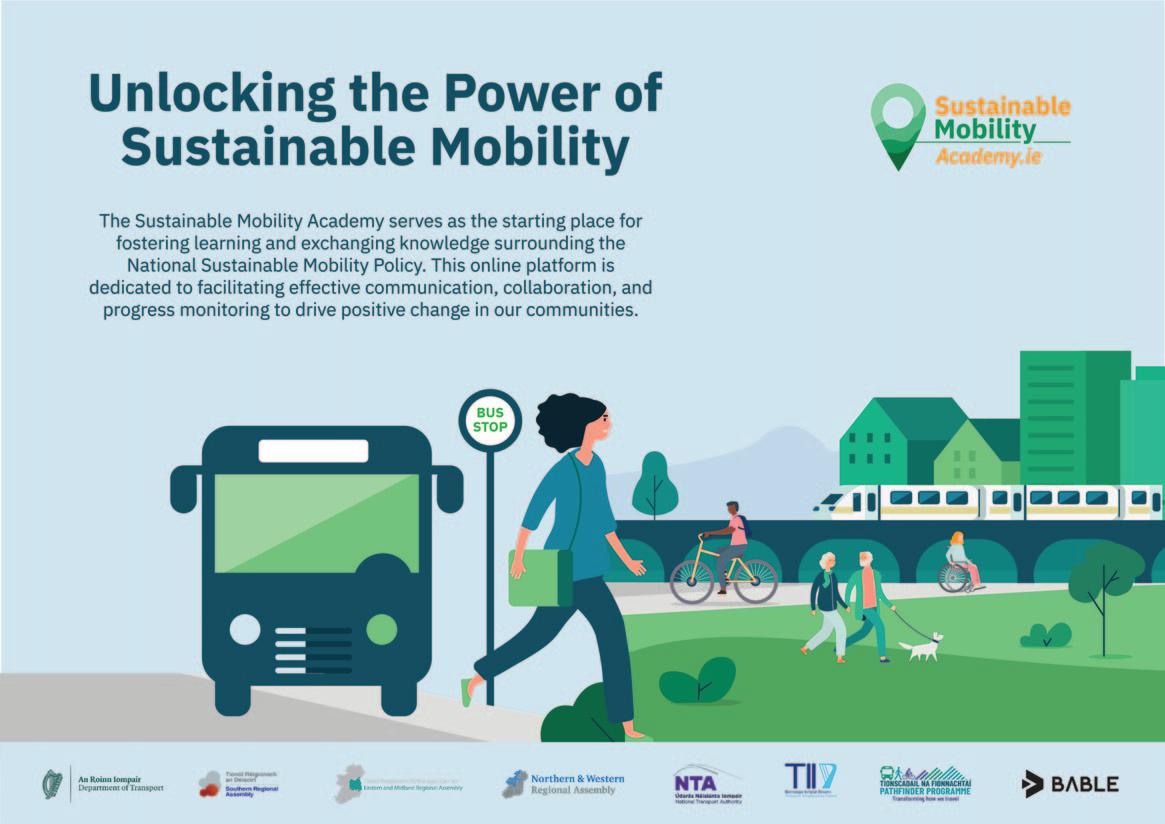
must plan for their use in a better way.
This strategy is all about finding new approaches to making travel, by whatever means, more efficient and pleasant for everybody. While decarbonising transport is absolutely crucial in fighting climate change, the benefits of transport efficiency reach much further. Changing our approach to transport means changing lives for the better.
Moving Together goes hand-in-hand with the extensive range of government investment and supports already in place or planned. It makes clear that the benefits of current and future government investment and supports in public transport, walking, cycling and electric vehicles cannot be fully realised while current levels of congestion remain. Heavy traffic makes public transport less reliable, often discouraging people from using it. It also makes the environment for vulnerable road users, such as pedestrians and cyclists, less safe.
This, too, discourages people from using active travel, particularly for shorter journeys. Ultimately, the aim of this new strategy is to support better and more liveable towns and cities, cleaner air, timely public transport, and safer spaces for walking and cycling.
The strategy is high level in nature and touches on a vast array of government policies and programmes. It proposes 35 recommendations, which are outlined in more detail in its accompanying Implementation Plan. The strategy will also ensure that the necessary guidance is in place for local authorities and local council representatives to develop plans for their own areas – plans that are tailored to best suit the bespoke needs of each individual community. A newly launched Sustainable Mobility Academy will also assist local authorities in this undertaking.
I really believe that the approach advocated in this strategy, which is open for consultation until 21 August 2024, has the potential to unlock transformative change in how we move around our country, our towns and our cities. But what do eolas Magazine’s readers think? I would love to hear your views in our consultation.
The Sustainable Mobility Academy is an online platform dedicated to effective communication and collaboration across the sustainable mobility sector. It was launched at the National Sustainable Mobility Forum in Portlaoise, County Laois on 23 May 2024.
As of April 2024, the Academy hosts more than 150 registered users and has been visited nearly 2,500 times. Visitors can access 97 Irish and European use cases, 65 public-sector resources, as well as links to latest research, news and events.
The Academy helps accelerate the implementation of sustainable mobility projects by acting as a ‘go-to’ location for sharing practice and insights among sustainable mobility practitioners.
The Academy covers a wide range of topics including active travel infrastructure, roadspace re-allocation, shared mobility modes, mobility hubs as well as data analytics, public engagement and behaviour change initiatives. Explore the Sustainable Mobility Academy and sign up at: www.sustainablemobilityacademy.ie

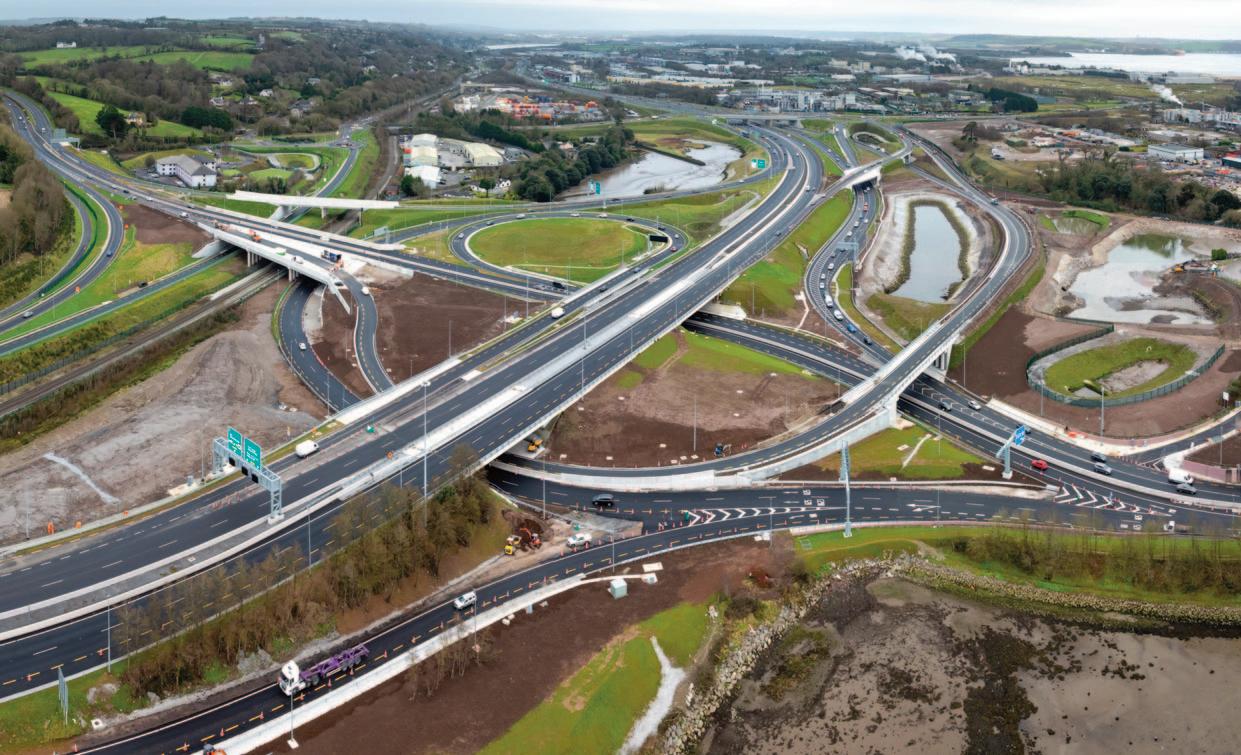

Jacobs’ Project Manager Patrick de Feu managed the Works Monitoring team and technical advisory deliverables on this considerable project, which was delivered on budget and ahead of programme within challenging constraints including construction during the Covid-19 pandemic.
The new Dunkettle Interchange in Cork is a major junction reconfiguration to create a signal-free junction between the strategically important M8, N25 and N40 to the east of the city, reducing travel times and improving capacity and safety.
Transport Infrastructure Ireland (TII) aimed to significantly improve the existing junction layout for all users, including the junction safety, operation and capacity at this strategically important interface. Located in an intertidal area of conservation with important flora and fauna, all works had to be undertaken while maintaining full operation of the junction and the railway line running through the site.

Over 12 years, Jacobs has been TII’s trusted consultant to cover a range of complex challenges on the Dunkettle Interchange project. These have spanned a range of delivery phases, each with their own unique requirements.
Working in partnership with Cork County Council and Cork City Council to deliver the scheme, TII’s mission is to deliver transport infrastructure and services, which contribute to the quality of life for the people of Ireland and support the country’s economic growth.
interchange in advance of and throughout construction. This communication and engagement focused on early sharing of works plans, timely traffic impact updates and being conscious of and managing the impact our scheme may have on the local population.
“Jacobs’ involvement in this project has spanned over a decade, and it has allowed us to truly put our stamp on it. We have been given the opportunity to help create a major interchange that handles four key roads, sees up to 120,000 vehicles pass through it each day, and has removed all traffic signals on the main interactions, providing free flow movements and reducing travel times in the region.”
The challenge was complex: The volume of traffic and outdated junction configuration was severely impacting traffic into and out of Cork at the intersection of four key national routes. The importance of the interchange to regional traffic was equalled by the sensitivity of the surrounding flood plain and foreshore, sensitive interlinked intertidal ponds which manage daily sea level changes, and the Cork Harbour Special Protection Area which the site sits in. In addition, Jacobs supported in ensuring the site work could start and continue throughout the Covid-19 pandemic, with all associated on-site health and safety requirements.
The solution included a major reconfiguration of link upgrades and structures: This encompassed direct road links, a grade separated junction arrangement to the east of the existing Dunkettle Interchange, four new roundabouts, 52 structures of various forms, intelligent transport systems, pedestrian and cyclist facilities, and several culverts where the scheme crosses watercourses or intertidal areas.
From the very start of the early design, statutory consenting and regulatory body consultations, our approach has been full and open engagement with all stakeholders. This has built a project ecosystem which encourages direct communication, early engagement around risks, and an openness to challenge how best to deliver a project of this scale and complexity.
Acting as the employer’s representative on site, our strong client relationship enabled all project and business risks to be dealt with pragmatically. Similarly, we worked collaboratively with the contractor and their designer, always focusing on the key project objectives. Crucially, our site team invested in building a relationship with all local stakeholders and the wider users of the
Our key technical challenges related to the complex intertidal drainage regime already in place, the challenge around the sensitivity of the current drainage and land layout to flooding, the difficult ground conditions our geotechnical team had to work with, and the structures team input to developing major interchange solutions in challenging ground. Our team developed and optimised a complex traffic model which considered the regional importance of this interchange. In addition, we ensured it could all be constructed safely while maintaining full junction operation with a live railway running through the site.
During the procurement process and subsequent construction monitoring and contract administration, this approach of open engagement and willingness to work as a larger team ensured the project completed on site ahead of schedule, which was an achievement in itself, given the working restrictions that Covid-19 placed on works throughout the construction.
Sustainability elements of the project were key: For example, over 2,400m3 of planings were taken from the runway at Cork Airport for reuse in temporary haul routes on site. Similarly, over 134,000m3 of earthworks fill were taken from local housing projects for reuse on site.
As key enablers and providers for transport infrastructure upgrades in the Cork region, we support a range of projects bringing industry-leading technical solutions and deep experience to help deliver outcomes that improve quality of life for communities, and support sustainability, social equity and the economy.
W: www.jacobs.com





Shane McDonagh, an International Energy Agency research analyst and former researcher at UCC’s MaREI, talks about the global transport sector in a net zero future.
Overall, McDonagh outlines that electrification is the main lever for reducing emissions in the transport sector.
“Technology performance such as efficiency improvements and behaviour measures are also important in the near term with hydrogen and hydrogen-based fuels becoming important levers after 2030,” he adds.
According to McDonagh, rail is “fairly easy” to electrify and is “already electrified in many places”. “By 2050 over 90 per cent of rail lines will be electrified and the segment is almost fully decarbonised,” he says.
In addition, although the overall objective is to reduce car usage through better public transport and active travel enabled by better planning, McDonagh expresses optimism for the progress made in the transition to electric vehicles (EVs).
In a broader global context, in 2023 EVs accounted for 18 per cent of all car sales, up from 14 per cent in 2022.
McDonagh states that: “Beyond 2024, we see sales further increasing across the board, even as subsidies are progressively phased out like in China or several European countries.


“In China, EVs are relatively affordable, and there is still support at the regional and city level. In the EU, the increased CO2 emissions standards, backed by the Net Zero Industry Act and other legislation have increased ambition to 2035. In the USA, the Inflation Reduction Act (IRA) has set new incentives for carmakers to produce EVs in North America. Countries like Australia are now also setting ambitious CO2 standards which will drive EV sales.”
In shipping, biofuels are to be increasingly used, reaching about 20 per cent of fuel demand, but due to limits on sustainable biomass availability and competition with the aviation industry, McDonagh asserts that though much of the early progress has been made in methanol, ammonia could emerge as the most dominant low carbon emission fuel in 2050, meeting about 50 per cent of fuel demand.
“Hydrogen, which is not as well suited as ammonia or biofuels for long, transoceanic journeys, is used for shorter range coastal vessels. Hydrogen reaches 15 per cent of shipping fuel demand in 2050, and the other 15 per cent of fuel still comes from oil.”
McDonagh states that it looks likely that any low or zero carbon fuel suitable for shipping will be “more expensive than the fossil fuels currently used”.
“The adoption of low and zero carbon fuels is likely to require setting some form of price mechanism that aims at creating greater market equality.”
Although he acknowledges that behavioural change is an “important tool,” McDonagh says that “the scale of the effect [of behavioural change] though significant, can be easily overstated”.
“The vast majority of the heavy lifting comes from electrification, and in places where behaviour is key such as aviation, options like high-speed rail present an often better – or at least more palatable – approach than cutting flights.
“I believe many flights can be cut with little effect on people such as business flights, but in general modal shift is more effective. I think France’s law that prioritises trains over planes is a good example of this.”
“Reducing business travel and long-haul flights (over six hours flying time), predominantly in advanced economies, saves around 170 MtCO2e, or 40 per cent of the remaining emissions from this sector in 2050,” he says.
This also reduces demand for modern bioenergy by 1.5EJ, or 3 per cent, in 2050, which McDonagh analogises as “planting a land area roughly the size of Greece”.
Although 60 per cent of car sales being electric vehicles by 2030 is achieved in the IEA’s net zero emissions by 2050 scenario, four-out-of-five cars on the road are still internal combustion engines. In the net zero emissions by 2050 scenario, behavioural changes such as restricting the use of conventional vehicles in large cities cuts CO2 emissions from road transport by 15 per cent or 700 MtCO2e in 2030.
Achieving the necessary emissions reductions in end-uses without such behavioural changes would require “ramping-up low carbon technologies at even more staggering speeds”.
Concluding, McDonagh reiterates that the key to achieving a sustainable transport system which can support a net zero future remains electrification and its supporting infrastructure, with hydrogen and biofuels playing a large role in the medium to long term, all the while supported by the adoption of behavioural change.

NTA’s ambitious BusConnects programme is starting to make an impact with real progress across all aspects of the plan. As planning applications for infrastructure are granted, and as new routes and improved services are developed and implemented, we are beginning to see BusConnects deliver for people and communities in our cities, writes Anne Graham, NTA CEO.
The BusConnects Programme is a strategic national-level programme aimed at enhancing sustainable transport across five regions in Ireland—Dublin, Cork, Limerick, Galway, and Waterford.
The vision of the BusConnects Programme is to connect people and places through an enhanced bus system while also improving cycling and pedestrian facilities.
The scale and transformative potential of the BusConnects Programme reinforces its central role in influencing the future roadmap of Ireland’s transport system.
It delivers on commitments within the National Development Plan 2021-2030, the Transport Strategy for the Greater
Dublin Area 2022- 2042, the Climate Action Plan 2023, and the National Planning Framework 2040
Details of the Programme were announced in 2018, and now the plans are coming to fruition. Since January, An Bord Pleanála has approved the development of four new bus corridors in Dublin, marking a significant milestone for NTA. These corridors are part of our overall strategy to enhance the efficiency and reliability of the bus network in Dublin and its surrounding areas.
Each of these corridors: Clongriffin; Liffey Valley; Ballymun/Finglas; and Belfield/Blackrock are designed to address specific areas of need by making bus services more useful for
more people.
These bus corridors will not only benefit passengers by providing faster and more reliable bus services but will also help to reduce congestion and air pollution in Dublin. By encouraging more people to use public transportation, the NTA is contributing to a more sustainable and environmentally friendly transport system.
Overall, the approval of these four bus corridors marks a significant step forward for public transportation in Ireland, and the NTA’s efforts to improve the bus network are sure to benefit passengers and the environment for years to come.
It is expected that the first two contracts will commence construction in the first half of 2025, followed subsequently by the award of an additional two schemes for construction.
Implementing the redesigned network of bus services for Dublin, a related but separate part of BusConnects, is making even more progress.
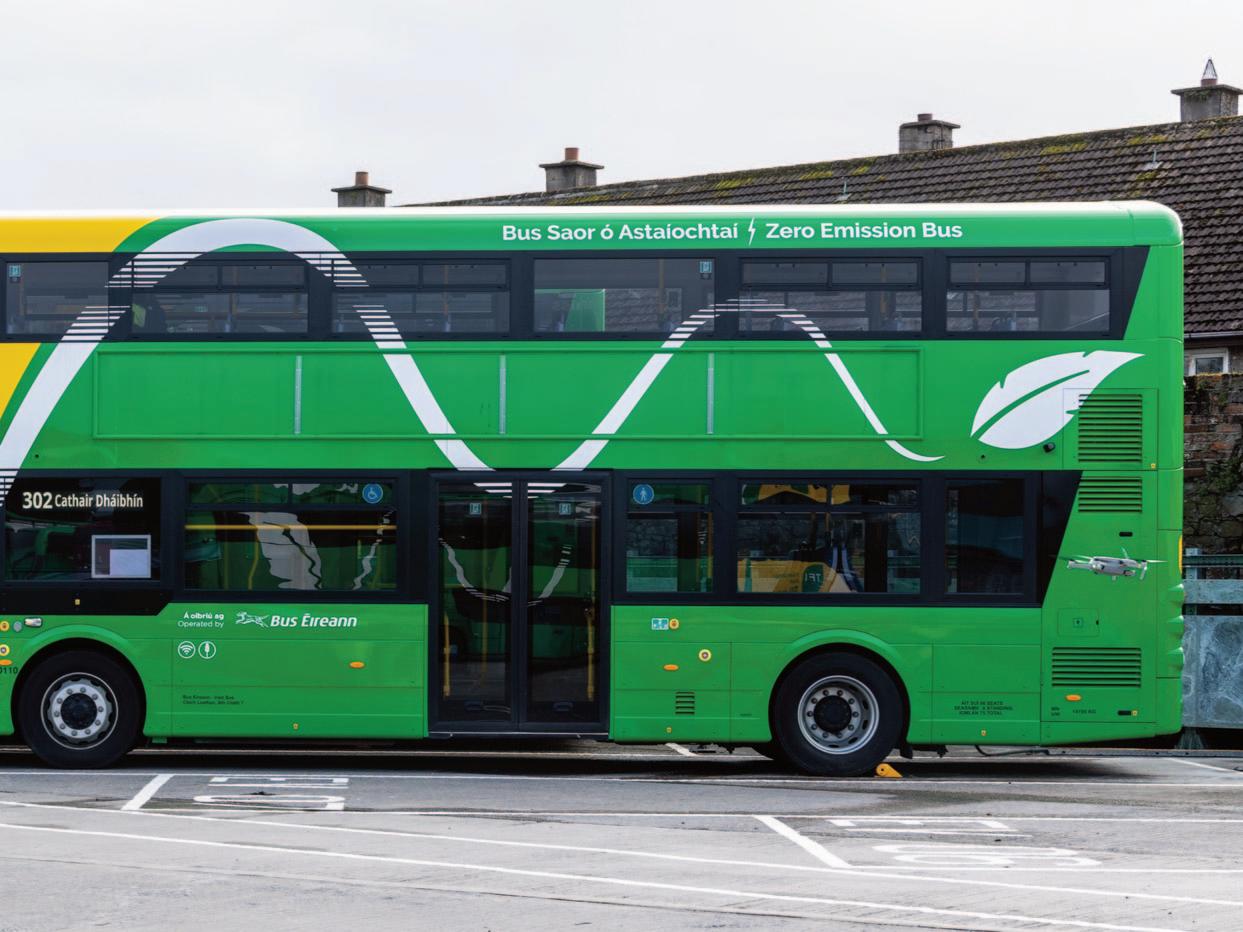
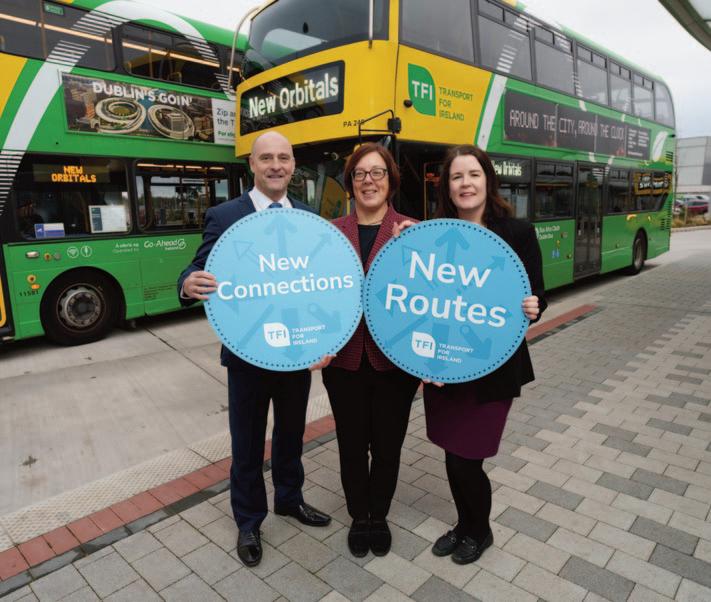
The re-imagined network is based on a structure of eight high-frequency spines, augmented by new local, orbital, and radial routes.
This will mean more frequent services particularly at off-peak and at weekends, new 24-hour services, and better connectivity and coverage including more orbital connections.
Following three rounds of public consultation that began in 2017, the NTA finalised and published the new Dublin area bus network in September 2020. The overall objective of the new network is to provide a network that better meets the needs of the overall region, taking into account the growing population and changing travel patterns.
Key characteristics of the proposals include a simpler network centred on eight main spines labelled A to H, more frequent services, particularly off-peak and at weekends, plus better coverage of the city including more orbital connections.
This new bus network plan took into account feedback provided by over 72,000 submissions at various stages of public consultation.
Key performance indicators (KPIs) are being used to measure the progress and realisation of network redesign and the broader BusConnects Dublin Programme benefits as the project rolls out. These KPIs include passenger boardings, punctuality, regularity, reliability, and access to opportunities, with improvements reported
across the board as the phases are rolled out.
The increased coverage and frequency of services associated with the Network Redesign Phases introduced to date have resulted in a large increase in the number of people in Dublin who have access to frequent public transport services to avail of employment, retail and social opportunities.
The new network is being implemented over 11 phases. Five of those are already complete, with two more to be delivered by the end of 2024.
The response by the travelling public has been very positive, with passenger growth in areas where the new network is in place substantially outperforming the growth on the rest of the network.
We hope to provide similar improvements to networks in our regional cities.
After two rounds of public consultation in Cork city, we are planning to increase overall services by over 50 per cent starting in 2025. This will include two 24-hour bus services, seven all-day high-frequency bus routes, and brand new routes to previously unserved areas such as Upper Glanmire, Waterfall, and Kerry Pike.
The new network for Limerick city is scheduled to be introduced in 2025. Under this plan, service levels are to increase by 70 per cent, thanks to the extension of bus services to new areas, more routes with frequent services, and an enhanced Sunday timetable. We also want to introduce a new 24-hour bus service operating between
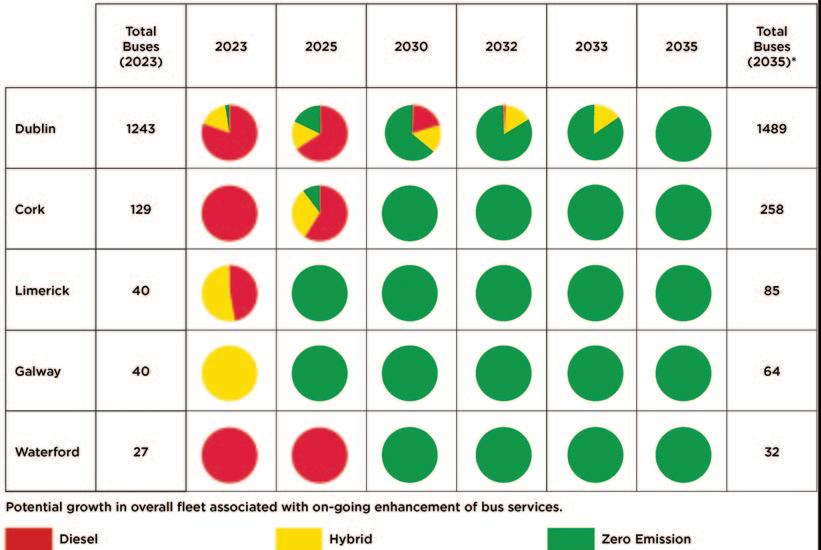
University Hospital Limerick, the city centre and the University of Limerick.
For Galway city, the new bus network will enable more people to avail of public transport resulting in increased access to a greater number of schools and workplaces across Galway city, Bearna, and Oranmore. Under the new plan, 67 per cent of residents will live within 400 metres of a high-frequency bus route.
Meanwhile, public consultation for a new network in Waterford city is getting underway in July 2024.
Transitioning to zero-emission vehicles is a core aspect of the BusConnects programme and there are now battery-electric buses operating in three centres, with NTA taking the lead in procuring and purchasing the vehicles to be deployed on our city and town services.
Bus Éireann’s town service in Athlone became fully-electric in January 2023, and earlier in 2024, thanks to €54 million investment by NTA, a total of 34 new state-of-the-art double-deck battery-electric buses became operational on their city services in Limerick, with a further 21 to follow. Progress is also being made with Dublin Bus. At the end of last year, NTA investment enabled the electrification of their Summerhill depot, followed earlier this year, by the Phibsboro depot. By August 2024, some 100 zero-emission vehicles will be operational in the Dublin fleet, offering a better experience for customers and cleaner air for the city.
The NTA intends that 85 per cent of the Dublin Metropolitan Area urban bus network will be operated by low and zero-emission buses by 2032, and solely by zero-emission buses by 2035.
BusConnects also provides for a major programme of investment in Next Generation Ticketing (NGT). The ticketing system on rail and bus is approaching the end of its useful life and requires updating to a more modern, faster and more efficient system.
As part of the BusConnects Programme, a new ticketing system will be introduced which will incorporate the latest developments in accountbased ticketing technology, including allowing the use of credit/debit cards or mobile devices as a convenient means of payment. It will also facilitate more ticketing innovations which cannot be currently provided in the existing system, as well as allowing for a more efficient process of altering fares.
Following a highly competitive procurement process, the NTA awarded, in April 2024, an overall framework contract for the design, supply, installation and operation of a new multi-modal ticketing system to a Spanish information technology company – Indra Sistemas S.A. – who have designed, installed and operated similar systems internationally.
This is a large and complex technology project and it is likely to take three to four years to fully roll out the new system. Exact timelines will be finalised in the coming months as the newly appointed supplier commences the detailed design stage of the project.
BusConnects also promised a simpler fare structure, and for the Dublin area, this was introduced in November 2021.
The central component of the new structure is a 90-minute fare (TFI-90) that allows customers to seamlessly switch between any combination of bus, DART, commuter rail and Luas services at
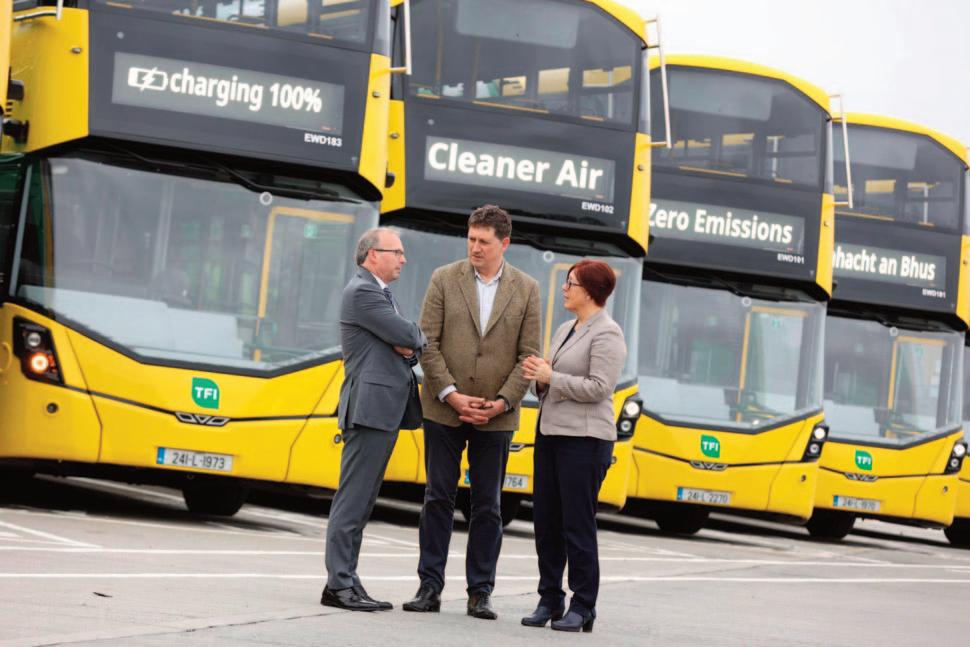
no extra cost subject to commencing the last leg within 90 minutes of first boarding.
The new system has dramatically improved the ease and convenience of movement between different modes of transportation and different services of the same transport mode, opening up exciting new travel opportunities for many people.
The TFI-90 fare currently stands at €2, offering unprecedented value to all users.
The BusConnects Dublin Programme includes the construction of enhanced bus stops and shelters across Dublin to align with the redesigned network and Core Bus Corridors.
Along the 12 Core Bus Corridors, enhanced bus stops, most to be equipped with bus shelters and realtime passenger information signs, will be provided as part of the construction of the individual corridors.
Along the other sections of the new bus network, new TFI bus poles are being installed in tandem with the roll-out of the different phases of that network.
The BusConnects Programme represents a transformation of the city bus service. Rather than focusing solely on individual projects, BusConnects adopts a holistic approach for the Programme to deliver outcomes that exceed the sum of its parts. By
seamlessly integrating bus corridors, cycling infrastructure, pedestrian pathways, new routes, fares, livery, stops and shelters, zero-emission fleet and a new ticketing system, the Programme aims to improve the bus service in a way that brings more value to the user than benefits from individual projects.
Although benefits have already been realised on components of the BusConnects Programme initiated to date, it will continue to deliver for the public well into the future.
While the implementation of the various aspects of BusConnects is only now gathering pace, the benefits are already being felt.
Zero-emissions vehicles now in operation offer a better experience for customers and cleaner air for communities.
The new network is already providing earlier starts and later finishes, more 24hour services and new orbital routes. This enhanced connectivity is creating a public transport system that is more useful to more people, with members of the public responding by using city bus services in greater numbers than ever before.
The TFI-90 fare has made it easier than ever to interchange from one service to another or one mode to another and offers great value to all users.
And there is more to come.
The completion over the coming years of our core bus corridors, with the bus priority they offer, will lead to faster bus journeys, along with greater punctuality and reliability, making the bus an even more attractive option.
The new network, when completed, will mean that whether it is for work, learning or socialising, all users will benefit from greater connectivity and integration, encouraging more people to get on board.
This is what BusConnects is all about. Connecting people and places by putting the bus at the heart of our cities.
T: +353 1 879 8300
E: info@nationaltransport.ie
W: www.nationaltransport.ie

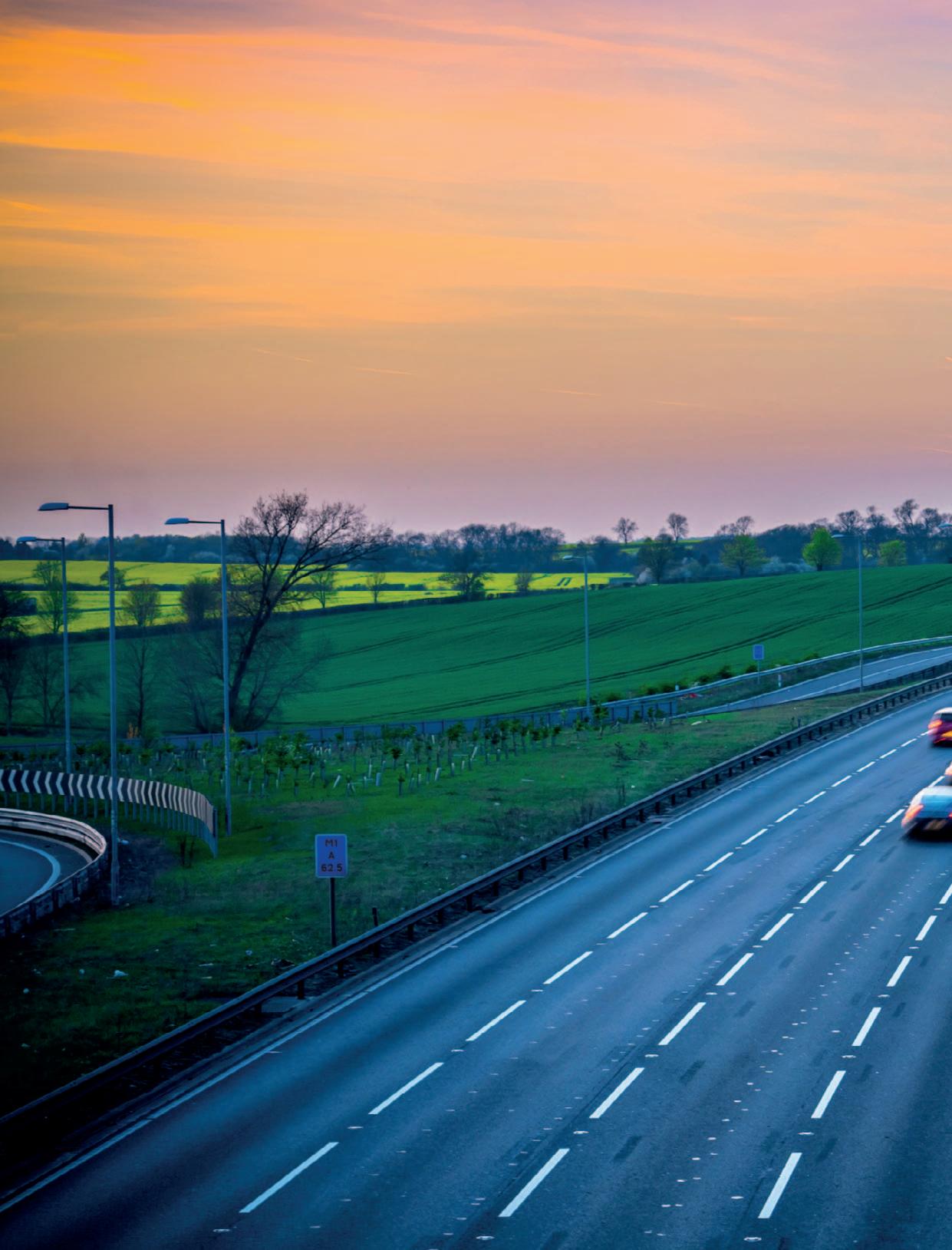
Moving Together: A Strategic Approach to the Improved Efficiency of the Transport System in Ireland aims to alleviate the economic and social costs of congestion and car-dependency in tandem with investment and scale-up in public transport, active travel, and EV infrastructure. With the number of licensed vehicles having increased by 215 per cent from 915,000 in 1985 to 2.9 million in 2021, the strategy unsurprisingly highlights the car as the most dominant form of inland transport in Ireland.
Recognising that the car will remain the dominant mode of transport for many people, the Strategy states that the Government is mindful of the needs of people for whom the car is the only viable transport choice, namely “captive car-users”.
Focusing on the impetus arising from commitments in Climate Action Plan 2023, which sets a target of achieving a reduction in 20 per cent in total vehicle kilometres and a reduction in fuel usage of 50 per cent by 2030, Moving Together intends to improve journey times for car drivers, public transport users, business, and freight, thus leading to “improvements in local air quality and reduced stress with associated health benefits for drivers and non-drivers alike”.
Furthermore, the Strategy aims to form a key part of the Government’s decarbonisation pathway for the transport sector and states that it “aims to go handin-hand with government investment and supports already in place or planned for public transport, walking, cycling, and electric vehicles”.
Whilst the strategy does not contain a prospective series of actions, there is acknowledgment that it instead “provides a firm policy direction and suite of options –such as road space reallocation, progressive taxation, freight efficiency, or behavioural incentives”.
In respect of this, the recommendations intend to provide guidance needed for local authorities and local council representatives to develop plans for their own areas.
On a broader context, the strategy states that it aims to provide an overarching framework for the development and delivery of potential demand management.
The strategy outlines: “In the Greater Dublin Area, congestion was estimated to cost the economy €336 million in 2022, rising to about €1.5 billion by 2040. Nationally, congestion is projected to cost €2 billion by 2040. There are also many significant environmental, health and social costs, including poor air quality and the negative impacts of stress, inactivity, or time away from family or community.”
However, the strategy also states that the benefits of current and future government investment and supports in public transport, walking, cycling and electric vehicles “cannot be fully realised while current levels of congestion remain”.


According to a recent OECD report, Ireland’s transport system is “car dependent by design” and requires systemic transformation to reverse a car-centric model which has dominated planning and settlement patterns for decades. The recent National Household Travel Survey 2022 (NHTS) reported that almost seven in 10 (69 per cent) journeys in Ireland are made by car, with trips below 3km accounting for over a third (35 per cent) of all journeys nationally.
Aiming to be high level in nature, the strategy sets out 35 specific recommendations to reduce travel demand across society and the economy.
The recommendations are spread across the following themes and include:
• strengthening implementation of demand management across the national planning system;
• embedding the polluter pays principle in taxation policy over the medium to long-term;
• empowering and supporting local authorities to develop local-based transport plans;
• driving efficiency in the freight sector;
• strengthening supply side measures in public transport and active travel to complement demand management;
• providing enabling legislation to support appropriate measures to be taken;
• embedding demand management principles and practices across the public sector, making it a leading institution for change.
• engaging with education and sports sectors to embed demand management principles and practices;
• engaging with the business sector to embed demand management principles and practices;
• building the evidence base to inform policy choices and demonstrate success.
Minister for Transport Eamon Ryan TD says: “This strategy is a critical piece in the decarbonising jigsaw for transport, but its benefits are much wider than climate. It is about re-imagining and re-allocating our use of space, and about putting people, rather than cars, at the centre of our urban and transport planning, ensuring better and more liveable towns and cities. This does not mean that cars will not continue to be a vital part of our transport mix – for many people, particularly in rural or isolated areas, they will continue to be critical. However, what this strategy is about is finding innovative approaches to making travel, by whatever means, more efficient and pleasant for everybody.”
The Irish Planning Institute President Gavin Lawlor says: “Transportoriented development is key to us achieving our national climate objectives, however delivering on this ambition requires the acceleration of overdue planning guidelines and the delayed revision of the National Planning Framework, with more analysis of the reasons why urban sites are not being brought forward for development.
“All of this means that we need more coherence across local authorities, including parking standards for new developments, and delivering alternatives to car dependent housing.”

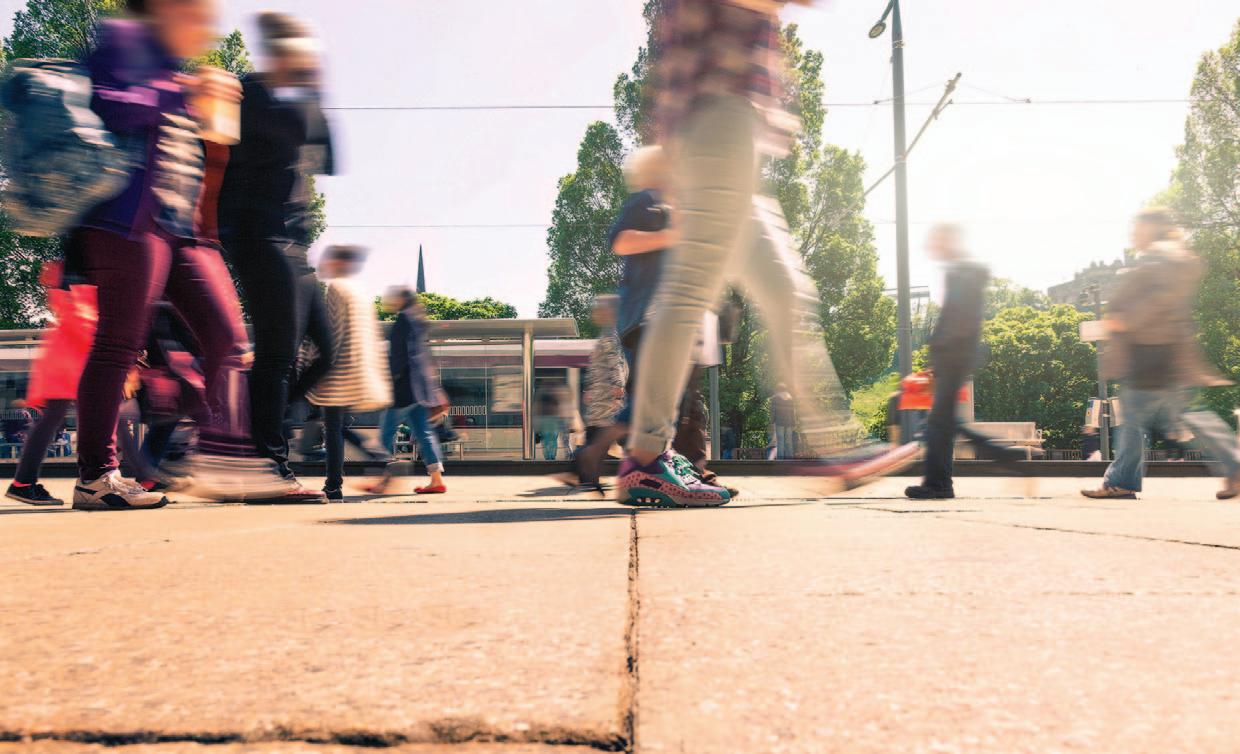
How do you drive social value and sustainability in transport
shares his project insights with using stakeholder engagement to drive a triple bottom line in major infrastructure.
Spoiler alert: There is no simple answer. Achieving social value and sustainability in transport infrastructure projects demands a meticulous blend of talent, technology, and strategy. Each project is a unique puzzle, shaped by the local context and the client’s needs. When you factor in the influences of climate change, economic pressure and political uncertainty, you are faced with one of the most formidable infrastructure challenges in the world. However, we do know one of the greatest ingredients for success –stakeholder engagement. It is both the fuel and the glue for these projects; it lays a deeper, more resilient foundation for collaboration and innovation across partners and communities. If done
correctly, it also uncovers more opportunities for social value and sustainability.
I have been privileged to work on several major infrastructure projects. These types of projects require massive construction at scale, which can heavily impact local communities in the short term, especially in urban areas.
Navigating this disruption requires strategies built on industry experience and data-driven insights and upgraded with the latest digital tools for communications, consultations, planning and engagement. It also requires a sustainability and social value lens in all decision-making. These are the lessons I have learned from over 30 years of engagement with local
authorities, multinational companies, and, most importantly, the public.
Take stakeholders on a journey, starting with the ‘why’
The motivation for better urban transport is clear: the most successful cities by any measure – including economic, environmental and social value – have efficient, sustainable and affordable public transport and insightled transport infrastructure. This is bolstered by active travel options and inclusive design.
Improving these veins and arteries of a city has a knock-on effect, as it drives up productivity and economic

opportunities. It has proven to make life better, cleaner and healthier for all citizens in the long term, but there is an asterisk. Achieving it requires disruption in the short term, and this needs to be carefully explained. All stakeholders need to understand the ‘why’ behind the project and be constantly reminded about the triple-line benefits. This is where multimedia communication technology, especially the remote, visually-based options, can help easily share the stories and narratives behind the long-term vision and changes needed.
“Building sustainable transport infrastructure that offers lasting positive outcomes is a massive, complex challenge, but it is also arguably the most effective way to upgrade cities.”
Silence on a project will be filled up with either fake news or speculation – both drive unnecessary friction. On a previous major project over two years, we constantly drove community education and engagement, and it meant we received just under 300 complaints across the lifespan – which is very low considering the scale of the project. We always gave the worst-case scenario and ensured there were no surprises – critical on any project. The goal is to help the stakeholders plan their lives better. In most cases, it is not just the residents you are speaking to. For example, on a street closure, you must let the local resident’s association and council know and put notices up for anyone using the road. It unlocks a ripple effect – you cannot have a mindset that your work only occurs within set boundaries. Share that information more widely, and you will reduce the disruption.
Your stakeholders will have different motivations, so you need to offer a selection of information triggers to satisfy them all. For some, it will be cost (cheaper transport) or ease of use (less traffic or transport time), while others will be focused on the environment (cleaner air and zero carbon options).
Early in my career, I picked up an apt description for this: Your information should be offered like a chest of drawers. Start with a menu, then provide detailed information in a drawer to suit the need. This information can also help educate and empower government officials (Teachtaí Dála [TD] and key community figures), as they will
be able to engage their constituents more effectively by providing them with the answers they need. Get this right, and they will become positive ambassadors for your project.
I am old enough to remember a time of slower communication thanks to landline phones and letters. Everything is now instant, and while it is more time and attention-intensive and drives up scrutiny, it also offers the huge gift of fast, recordable feedback. This offers a treasure trove of information and can lead to more innovation – especially within social value and sustainability. We can also safely and responsibly store anonymised, aggregated data on stakeholders, which makes it much easier to build relationships and raise collective project awareness. An example of that was with a pensioner in a neighbourhood where we were closing a road for construction. She recently had major heart surgery and was worried that she would not have access to her medical appointments due to the road closure.
She contacted us through one of the project channels, and thanks to our bespoke digital engagement tools, we captured all her medical appointments in our secure system. That meant anyone on the team could step in and help get her to her appointments, ensuring that our equipment and diggers were turned off and the road was clear as workers took lunch breaks over her appointment times.
Building sustainable transport infrastructure that offers lasting positive outcomes is a massive, complex challenge, but it is also arguably the most effective way to upgrade cities. These projects offer a proven formula for making citizens’ lives easier, better and healthier. The secret to getting that right is connecting and collaborating with stakeholders to make the right changes happen and unlock more social value and sustainability opportunities.
W: www.jacobs.com





Lucien Mattieu, Cars Director, Transport and Environment, Brussels, talks about the slowdown in the adoption of electric vehicles (EVs) currently taking place throughout the EU.
Although, in 2023, electric vehicles (EVs) accounted for 18.6 per cent of overall car sales in Ireland – a statistic which makes Ireland stronger in this area than all other countries in western Europe and the Nordic states with the exception of Belgium – there has been a slowdown in purchases throughout the EU following an initial sales boom.
Following the approval of the European Green Deal in 2020, sales of EVs spiked. Road transport accounts for a majority of EU emissions within the transport sector, and industry has been encouraged to adapt to long-term net zero obligations, with grants being offered to many EU citizens to encourage them to buy EVs.
However, the acceleration of this growth has slowed. This, according to Mattieu, is down to a number of factors, among which he describes as “inadequate” emissions reduction targets for 2029.
He explains: “Industry was sprung into action as there were new targets in 2020/2021. That is why there was an initial increase in EV sales. Unfortunately, the emissions reductions targets to 2029 are not very stringent, which means that interim emissions reductions targets can be met with just 22 per cent electric car sales.”
In the long term, EU car sales must be at least 60 per cent electric from 2030, with a 2035 target of ensuring that all car sales are electric vehicles.
In the two years where there is available data, Mattieu states that there has been a “sudden drop in the sale of small electric car models”. He rationalises: “In the last couple of years, car manufacturers have been prioritising the sales of larger car models such as SUVs which is being driven by a desire to make more profits.”

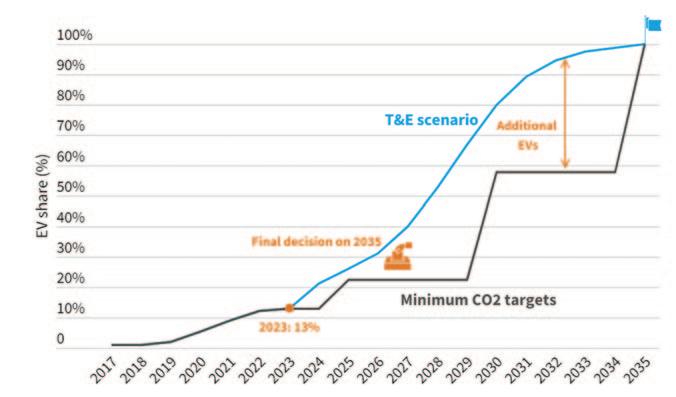
Source: Transport and Environment.
Referring to a survey of European car drivers carried out by Transport and Environment, Mattieu claims that if a smaller, affordable electric car was available on the market, this could significantly increase demand for electric cars from the current figure of 25 per cent of EU citizens interested in EVs to 35 per cent.
“We must reflect on what we consider affordable, because the average consumer in the EU does not have the ability to buy an electric vehicle, which costs minimum €25,000. People have this aspiration, so it is important to ensure that the EV market meets demand with production levels in the right volumes.”
Increasing the affordability of electric vehicles is an approach being taken by the Government of France. Mattieu explains: “What the French Government is doing, in a nutshell, is providing low income households with the opportunity to have an electric car for €100 per month. The [French] Government is essentially introducing a state-backed sponsorship scheme with subsidies that are targeted and ensuring that the people who have the lowest income have the ability and affordability to access these cars.”
Looking at the transport sector more broadly, Mattieu reflects that the overall objective of the transport sector throughout the EU is to ensure that all member states are able to meet net zero obligations.
He states that electric vehicles are “part of the solution”, but also outlines that other measures which decrease the volume of vehicles on the road is another branch of this wider strategy.
He states that while there is an EV slowdown, that the French Government provides the finest example of “perseverance” with the decarbonisation of transport.
With the French Government introducing both EV grants which make the vehicles affordable for lower-income French citizens, as well as a trebling parking fees which aims to disincentivise wider vehicle use in the French capital, Paris, he is optimistic that the road to net zero in the transport sector is “going in the right direction”.
“We know that a lot of cities are looking very closely at what Paris is doing and could aim to replicate it, so it sends an important signal. We need this kind of wide policy toolbox to ensure that every transition in the EU is affordable and environmentally responsible,” he concludes.

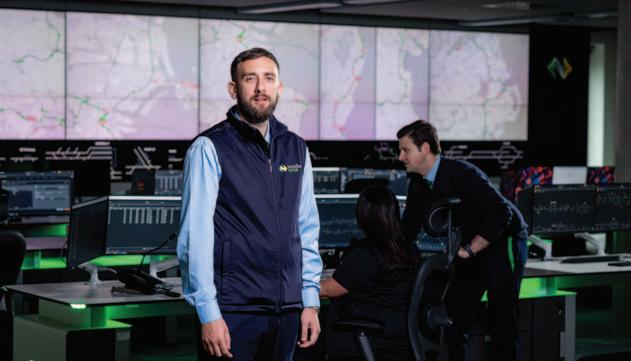
Capital investment in rail and Rosslare Europort has firmly moved from planning to delivery stage says Jim Meade, Chief Executive of Iarnród Éireann.
Our vision of being the backbone of Ireland’s sustainable transport network is clear and has rapidly moved from the vision to the planning stage, and now with the support of government and the National Transport Authority for the capital investment to achieve this, we are firmly in delivery mode.
Across all aspects of our business – for passenger and freight services on our rail network, and as Port Authority for Rosslare Europort – the decade of delivery is underway.
Already, 185 carriages of the new DART+ fleet are on order from Alstom –construction of the first two 5-carriage trains are well advanced, and they will arrive in September 2024. A detailed testing and regulatory approval process must follow for the first trains in the
fleet, which will see them entering service from late 2025 / early 2026.
The order could potentially increase to 750 carriages over the decade as the DART+ Programme develops, and as options for supporting infrastructure for battery-electric versions of the train are considered for rail services in Cork, Wicklow and elsewhere.
The fleet order is an integral part of DART+, an investment will see double the passenger capacity and treble the electrification across all Greater Dublin Area rail services.
Investment in infrastructure in the Dublin area will also grow our ability to operate services right around the country. Targeted line speed improvement works are also taking place. Construction of the new National
Train Control Centre at Heuston Station has been completed, with train control systems being developed for full commissioning by 2025, to deliver more efficient train management across the network, to cater for the expanded network and services.
€185 million is to be invested in the Cork commuter rail network, under the EU-funded Recovery and Resilience Plan, allowing Iarnród Éireann to treble the Cork commuter rail network’s capacity through:
• double-tracking Glounthaune to Midleton;
• developing a new through platform at Kent Station for through running for Mallow to Midleton/Cobh; and
• resignalling the Cork commuter network.
All three elements are now underway. Additionally, in May of this year, the planning process for the next phase of the Cork Area Commuter Rail Network investment began. Multi-disciplinary consultants have been appointed to support a railway order application process for eight new commuter stations, a new fleet maintenance depot, and the electrification of the Cork network.
In Galway, funding under the Urban Regeneration Development Fund (URDF) includes:
• investment for a 1km section of second track and a new platform at the existing Oranmore Train Station, which will allow the busy commuter link between Athenry and Galway to grow – a planning application was submitted in May 2024.
• Ceannt Station is being regenerated as part of a major Galway City Council Transport Connectivity project, with works underway since January 2024.
In Limerick, the completion of the city’s own transportation hub centred on

Colbert Station will also boost services, and the Limerick Shannon Metropolitan Area Transport Strategy has detailed the opportunities provided by the network of rail lines around Limerick City. Plans for new stations at Moyross and Ballysimon are currently progressing, and capacity studies are underway for Limerick Junction to Limerick to Ennis.
Waterford’s Plunkett Station is being relocated to be part of an integrated transport hub under plans to develop the city’s North Quays.
Iarnród Éireann’s Rail Freight 2040 Strategy aims to achieve:
• a five-fold increase in the number of rail freight services;
• a resulting reduction of 25,000 tonnes of CO2 emissions annually; and
• avoiding the requirement for 140,000 HGV journeys on our roads annually.
Works to reinstate the Limerick to Foynes rail line for freight services are underway following funding from the Department of Transport, a clear commitment to the goals of Rail Freight 2040, with a 2025 completion date planned.
Iarnród Éireann is also port authority for Rosslare Europort, and its status as Ireland’s Gateway to Europe has been confirmed with 36 services operating directly between the port and Europe each week.
DART+ West Maynooth/M3 Parkway to City, including new depot West of Maynooth
DART+ South West Hazelhatch to Heuston and Phoenix Park Tunnel
DART+ Coastal North Connolly to Drogheda
Railway order hearing held November 2023
An Bord Pleanála decision pending
Railway Order application lodged March 2023
Government approval to move to railway order phase
DART+ Coastal South Connolly to Greystones Emerging preferred option being developed
DART+ Fleet New trains for all DART+ routes above
185 DART+ carriages ordered
An Bord Pleanála decision pending
Railway order application expected to lodge imminently
Public consultation Q3 2024
First carriages arrive September 2024 enter service after testing and approval process late 2025/early 2026
As well as investment in the Port Masterplan, the OPW’s Project T7 for a permanent border control post, and the new TII N25 Rosslare Europort Access Road, an ambitious €200 million plan to become Ireland’s offshore renewable energy hub, with the port uniquely placed to support the development of the industry in the Celtic and Irish seas.
Our journey to our sustainable future is to a destination which will benefit our country, our environment, our communities and our society as a whole, and everyone is welcome on board.
W: www.irishrail.ie
X: @irishrail

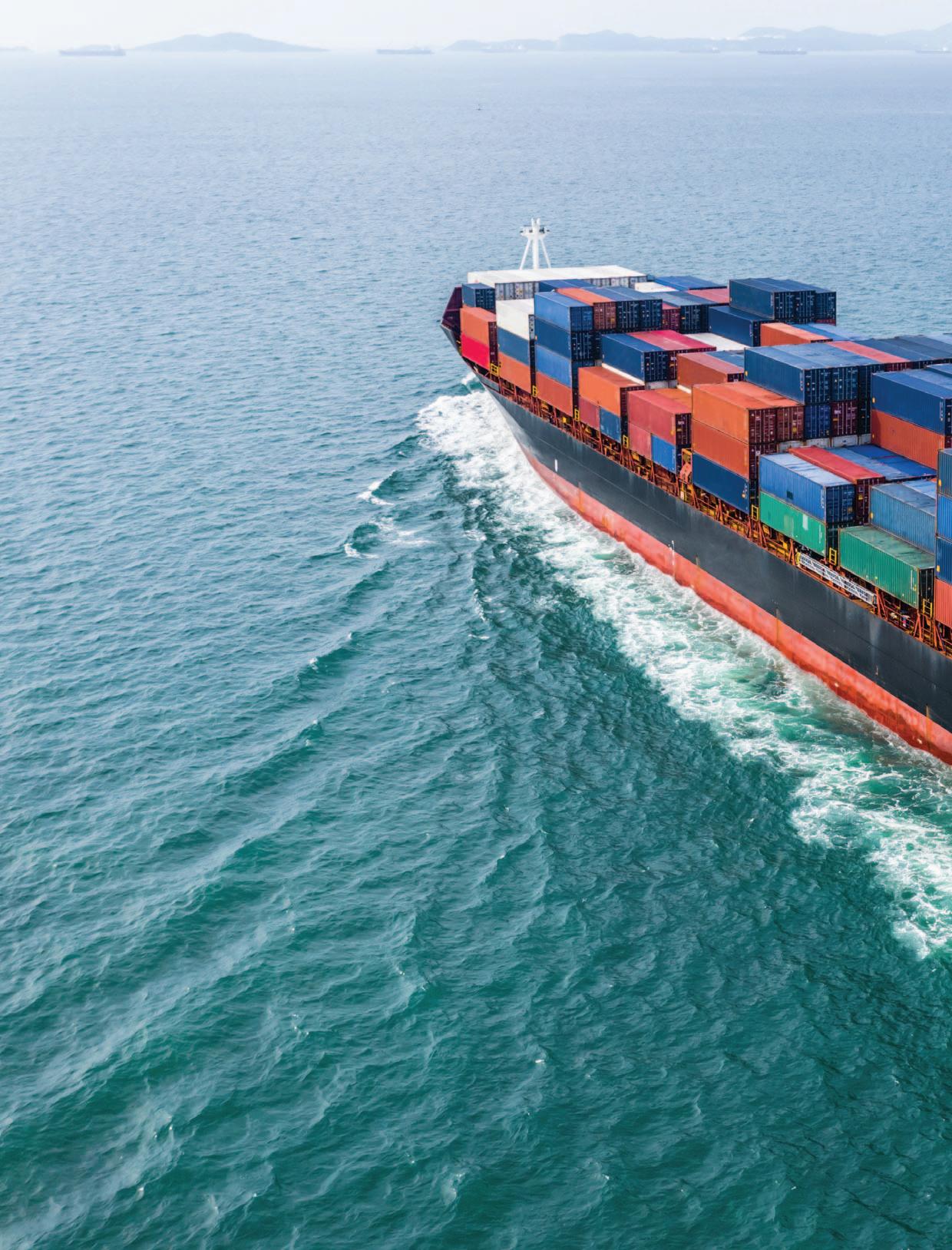
In January 2025, the FuelEU Maritime Regulation will enter into force, setting maximum limits for the average greenhouse intensity of the energy used by ships at European ports above a gross tonnage of 5,000.
Targets will ensure that the greenhouse gas intensity of fuels used in the sector will gradually decrease over time, starting with a 2 per cent decrease by 2025 and reaching up to an 80 per cent reduction by 2050.
The European Commission states that the targets will become “more ambitious over time” to stimulate and reflect the necessary developments in technology, as well as uptake in the production of renewable and low-carbon fuels.
Underpinning this is a proposed new incentive regime to support the uptake of renewable fuels of nonbiological origin (RFNBO) with a high decarbonisation potential, as well as the exclusion of fossil fuels from the regulation’s certification process.
The targets cover not only CO2 but also methane and nitrous oxide emissions over the full lifecycle of the fuels used onboard, on a well-to-wake (WtW) basis.
The Regulation also introduces additional zero-emission requirements for ships at berth, mandating the use of on-shore power supply (OPS) or alternative zeroemission technologies in ports, by passenger ships and containerships, to mitigate air pollution emissions in ports, which are often close to densely populated areas.
By taking a life-cycle, goal-based, and technology-neutral approach, the Commission is confident that FuelEU Maritime allows for innovation and the development of new sustainable fuels and energy conversion technologies, offering

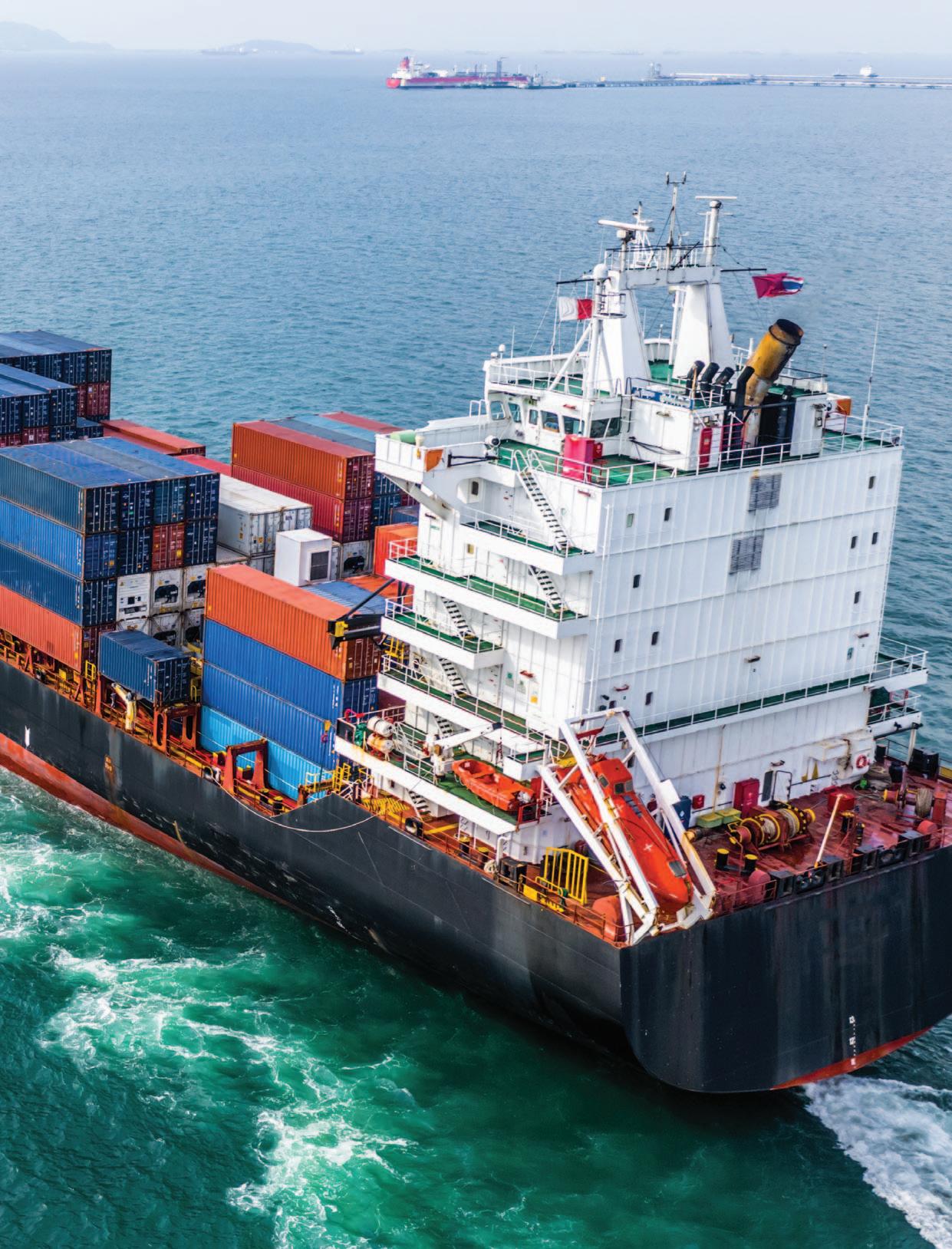
operators the freedom to decide which fuels to use based on ship-specific or operation-specific profiles.
The Regulation also provides for different flexibility mechanisms, aimed at supporting existing fleets to find suitable compliance strategies and incentivising companies by rewarding first-movers for early investment in energy transition.
The FuelEU maritime initiative is part of the Fit for 55 package. Presented by the European Commission on 14 July 2021, the package aims to enable the EU to reduce its net greenhouse gas emissions by at least 55 per cent by 2030 compared to 1990 levels and to achieve climate neutrality in 2050.
FuelEU Maritime will enter into force from 1 January 2025 except for Articles 8 and 9 on monitoring plans which shall apply from 31 August 2024.
In July 2023, shortly prior to the passage of FuelEU as part of the EU’s Fit for 55 package, the International Maritime Organization adopted a revised strategy for the reduction of greenhouse gas emissions from ships internationally, which forms the basis of the EU regulation.
The IMO strategy includes a provision for an economic element on the basis of a maritime GHG emission pricing mechanism.
With the support of Minister for Transport Eamon Ryan TD, global governments are in agreement, with the revised Strategy setting a goal of net zero greenhouse gas emissions from ships by or around 2050. This is a significant increase in ambition compared to the initial 2018 strategy which targeted a 50 per cent reduction compared to 2008 levels.
The IMO strategy has introduced important indicative checkpoints along this 2050 pathway. The 2030 checkpoint is set at reducing GHG emissions from ships by at least 20 per cent, while striving for 30 per cent. For 2040, this stands at 70 per cent while striving for 80 per cent in 2040. Both checkpoints are in comparison to 2008 levels.
Significantly, the strategy includes a basket of candidate mid-term GHG reduction measures including an economic element on the basis of maritime GHG emissions pricing.
Speaking following the negotiations resulting in the IMO strategy, Minister Ryan said: “It is really encouraging to see that this globally agreed strategy, which will accelerate the sector’s transition away from polluting fossil fuels, now also, significantly and bravely, provides for a pricing mechanism.
“The key thing now is to go to the next steps, turning this agreed strategy into action.”


Marking 20 years of operating and maintaining Luas in Dublin, Eoghan Sweeney, Deputy Managing Director and Dave Rooney, Director of Operations with Transdev Dublin Light Rail (TDLR) speak with eolas Magazine about post-pandemic recovery, recruitment, and network extension.
Luas was launched in Dublin with the opening of the green line on 30 June 2004 followed by the red line three months later on 26 September. Following the official opening, 430,000 passengers availed of four days of free travel. Then-Minister for Transport, the late Séamus Brennan, remarked: “Today, Luas returned a tram service to Dublin, 45 years since it finished. It reflects a new vibrant Dublin and the country as a whole.” Brennan’s comments proved prescient.
Reflecting on this 20-year journey, the Deputy Managing Director expresses his pride that Transdev has operated and recently maintained the Luas for the entirety of its existence. “Luas has been hugely successful due to the really positive delivery by Transdev, with total passenger journeys increasing in 12 out of the 20 years,” Sweeney says, adding: “Today, one-in-five public transport journeys in Dublin are now taken via Luas, exceeding all targets that we had initially set.”
“Transdev is a great business to grow in.” Rooney observes, adding: “In fact, the driver of the very first tram in passenger service, Eddie Byrne, remains with the business today as a senior trainer.”
Having originally worked as a traffic supervisor in 2004, Rooney himself now sits in the same control room, as Operations Director. Likewise, Sweeney started his Transdev career interning as an infrastructure and vehicle maintenance coordinator in 2010.
Remarking on the low turnover of staff in Transdev – many of whom, like himself, have been with the company for 20 years – Rooney attributes this to the close relationships TDLR cultivates. “We are very much a trusted partner, not only with our clients, but also with the communities in which we operate and our staff, many of whom emanate from those communities.
“There is very much a family atmosphere within TDLR. It is palpable. Visitors to our Red Cow depot often remark on the huge enthusiasm exhibited by our people, both for light rail itself and for what we do: moving people. That is our defining mission.”
Agreeing with this assessment, Sweeney adds: “With an average of 150,000 passenger journeys delivered each day, everyone here is incredibly proud to work for Transdev and Luas to deliver that service.”
Marking 20 years of TDLR and Luas in Dublin, the Minister for Transport will meet with Transdev, Transport Infrastructure Ireland, and the National Transport Authority for a celebration event at the St Stephen’s Green Luas stop on 30 June 2024. Internally then, TDLR will run a series of events to celebrate the last 20 years.
However, cognisant that the continued pursuit of its mission comes first, TDLR
is not resting on its laurels. In fact, the day before the anniversary, 29 June, will be the busiest day in the Luas calendar year. “With the Dublin LGBTQ Pride parade coinciding with several other public events, we will carry in excess of 150,000 people in one day. After that we can celebrate,” says Sweeney.
With more than 400,000 people living within 1km of its network, Luas serves communities across Dublin – north, south, east, and west. Transdev is cognisant that public transport networks can act as a catalyst for environmental, economic, and social development.
As such, through its wider community engagement programme, TDLR seeks to support some of Dublin’s most disadvantaged communities through partnerships with Fettercairn Community, Ballyogan, and St Patrick’s Athletic Football Club, as well as 16 local schools.
“We have an ongoing project there with St Pat’s Athletic and the Football Association of Ireland whereby we educate young people about the Luas and its benefits, and also supporting them in their education and career journeys. For instance, we facilitate work experience and conduct mock interviews.
“Likewise, when partnering with Business in the Community Ireland’s Skills @ Work Programme, TDLR linked with St Aidan’s Community School in Tallaght. The programme comprised a series of workshops held in the Red Cow Luas depot, providing insight into how we operate, the experience of a typical working day, and how to prepare to leave education,” Sweeney outlines.
Operating in 19 countries across five continents, Transdev employs over 100,000 people and is the leading operator and maintainer of light rail systems globally. “TDLR can draw on that expertise at any time if there is a challenge or a technical issue,” Sweeney explains.
“In 2022, for instance, as part of our business transformation we deployed 15 international experts across Dublin in support of Luas delivery. On the other hand, networks such as Sydney Light Rail have learnt a lot from Luas. Indeed, Brian Brennan, a previous Managing Director of TDLR is now the CEO of Transdev Australasia. It is a virtuous circle.”

“TDLR recognises that for public transport to be a viable option for people in the Greater Dublin Area, it must be seamless.”
Dave Rooney, Director of Operations, Transdev Dublin Light Rail
Emphasising the role of this international experience and the support of the wider Transdev Group, the Operations Director believes that Luas would not have achieved the same level of success it enjoys today.
“Joining a company like Transdev, which has a significant international footprint of light railway operations elsewhere in the world and bringing a tram system back to Dublin after a 45year absence was an incredible experience,” Rooney concurs.
The Covid pandemic had a significant impact on Luas services. In 2023, however, a total of 48.2 million
passenger journeys signalled a return to the pre-Covid 2019 peak “well ahead” of other European light rail transit (LRT) systems.
Conceding that the Covid pandemic was “quite a challenging time” for TDLR, Sweeney emphasises that “we continued to deliver Luas services for essential workers throughout that time”. Emerging from the pandemic, Transdev Ireland then launched a comprehensive business transformation strategy.
“We transformed the business,” he asserts, adding: “This ensured that we delivered across each of our metrics, and we are now exceeding our performance targets.”
TDRL has also responded to the new

“We are second only to Dublin Bus when it comes to total passenger journeys taken on the island of Ireland.”
Eoghan Sweeney, Deputy Managing Director, Transdev Dublin Light Rail
post-Covid travel patterns which have resulted in “increased off-peak and weekend travel”. “We have responded by reviewing the frequency of services in the evenings and at weekends and are set to implement these changes later in 2024,” Sweeney states.
Post-Covid, recruitment also became a major priority for Transdev Ireland. With increased activity in maintenance alongside three major overhauls in the Luas fleet, TDLR recruited more than 150 staff between 2022 and 2023, bringing the net total to over 650. However, in a tight labour market, achieving this was a challenge.
“Previously, Transdev Ireland had a bank of applications from prospective drivers and maintenance technicians on file. Now, with the economy operating at virtually full employment, we have had to recruit elsewhere due to a talent shortage in the State,” Sweeney explains.
Overall, while Luas came under intense scrutiny prior to its launch in 2004, the project has been a runaway success in terms of passenger growth. That popularity brings its own challenges, and while the initial trams were 30 metres in length, today the trams on the green line are among the longest in the world at 50 metres in length.
“As the economy has grown, more people need to move around Dublin. Luas is now the heavy lifter when it comes to moving those people. In fact, with a relatively small footprint, we are second only to Dublin Bus when it comes to total passenger journeys taken on the island of Ireland,” Sweeney indicates.
Discussing the success of the Luas, Rooney remarks on its global reputation. “One thing people probably do not realise about the light rail tram system in Dublin it is how well regarded it is internationally, among other public transport authorities.
“For example, if we compare Luas to Manchester Metrolink – which is twice as large in terms of track, rolling stock, and stations – we are carrying significantly more passengers each year.
“Similarly, many people will be unaware that at peak hours we carry as many as 400 people on a single green line tram. Running at a peak frequency, that is the equivalent of a Boeing 747 landing at St Stephen’s Green every three minutes. Luas demonstrates an unrivalled ability to move people across Dublin, especially when compared to other modes of transport.”
Commenting on TDLR’s “proven track record” in delivery network extension,
Rooney references the period between 2009 and 2011 when three major extensions to the Luas network took place within 18 months.
“That type of delivery is complex. It involves significant collaboration with clients to support system integration and testing. It also requires recruitment of drivers, engineers, and maintenance technicians to service the additional fleet,” he says.
Indeed, the Deputy Managing Director stresses that the success of the Luas network extensions to date “would not have been possible if we did not work in a partnership with our clients, with other transport providers, local authorities, and with the emergency services”.
“We are a partner in terms of public transport delivery in Dublin. In TDLR, public service takes primacy. That, to me, is one of our unique selling points,” Sweeney says.
Reinforcing this theme, the Operations Director notes that “we work very closely the other public transport operators in the State”.
“TDLR recognises that for public transport to be a viable option for people in the Greater Dublin Area, it must be seamless. In Dublin, each of the operators exhibit that ability to collaborate to achieve this,” Rooney says.
Further planned extensions to the network include Luas Finglas, which is expected to enter operation between five and seven years from now, followed by Luas Lucan. At the same time, Transport Infrastructure Ireland (TII) is in the process of procuring a new fleet of trams to replace those currently in operation on the red line.
Previously, Sweeney had served as department manager for the Luas Cross City extension to the green line. “Towards the end of the construction phase, TDLR began mobilising the extension. That meant commissioning and stress testing the installed systems followed by tests with rolling stock. We brought trams through the system to ensure all functions were working as designed. After running the frequency and headway that the system had been designed for, we then began comprehensive training along the new route for every single driver.
“The challenge of Luas Cross City was cutting through the heart of city, particularly around historic areas of the

city. That was a technical challenge. As such, much of the work was completed and assessed overnight,” he recalls.
While its construction was disruptive to the city, Luas Cross City was opened ahead of schedule and on budget. “Like the original system it was massively successful from day one and it really changed the system. Beforehand, we had two light rail lines with a short walk between them. Now, we have a tram network with people beginning journeys on the red line and completing them on the green line. The use of those connections has been a massive transformation.”
Following its opening, customer satisfaction with the new network exceeded 90 per cent. “Traditionally, the Luas has topped the Transport for Ireland customer satisfaction surveys ahead of other modes of transport. That is something to be proud of, though we cannot take it for granted. We work every day to ensure that we deliver the best possible service with the network we have in place,” observes Rooney.
Discussing the TDLR vision from an operations perspective, Rooney emphasises service quality. “Our priority is to deliver the quality of service that our
customers expect while simultaneously supporting TII to surpass the 50 million passenger per annum mark, an objective we expect to achieve in 2024.
“If we continue to deliver a reliable, frequent, and safe service as well as we have done, then we will continue to grow passenger numbers,” Rooney concludes.
Taking a longer-term view, Ben Dwars, CEO, TDLR, states that he is “looking forward to the future network growth, the introduction of the new red line fleet, maintenance, and digital enhancements which will deliver for Luas passengers and Dublin city an excellent customer experience”.
“With passenger numbers continuing to grow alongside the planned expansion of the network, our organisation will also grow and likely double over the next 20 years. We are looking forward to embracing this growth and delivering a high-quality light rail service in Dublin for the next 20 years,” Sweeney summarises.
For more information: Transdev Dublin Light Rail, Luas Depot, Clondalkin, D22 C5P3 T: 014614910


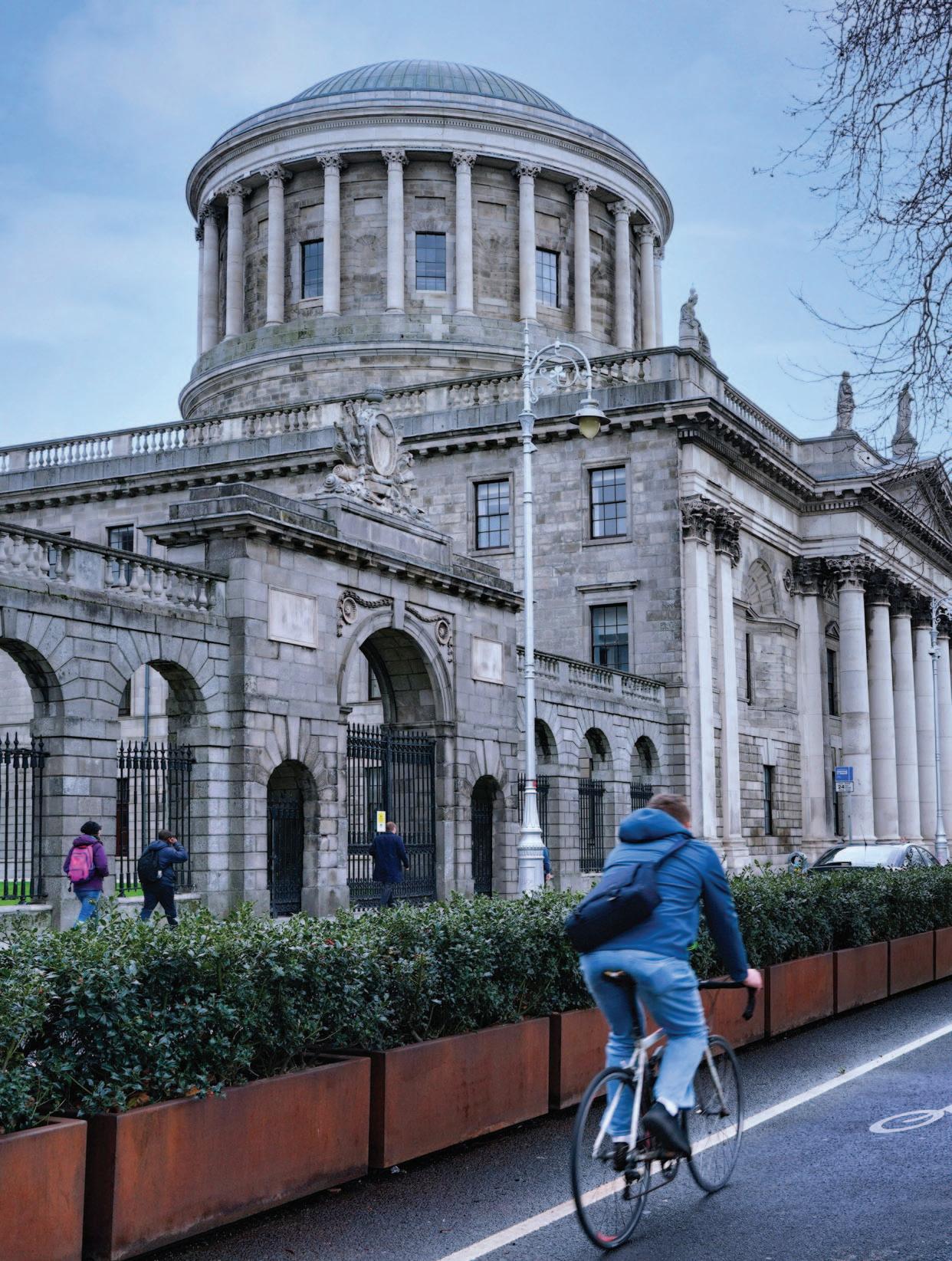
‘have more positive effects than people expect’
A study by the Economic and Social Research Institute (ESRI) states that if the benefits of cycle lanes in cities are to be maximised, that these must be enabled by traffic calming measures and segregation infrastructure.
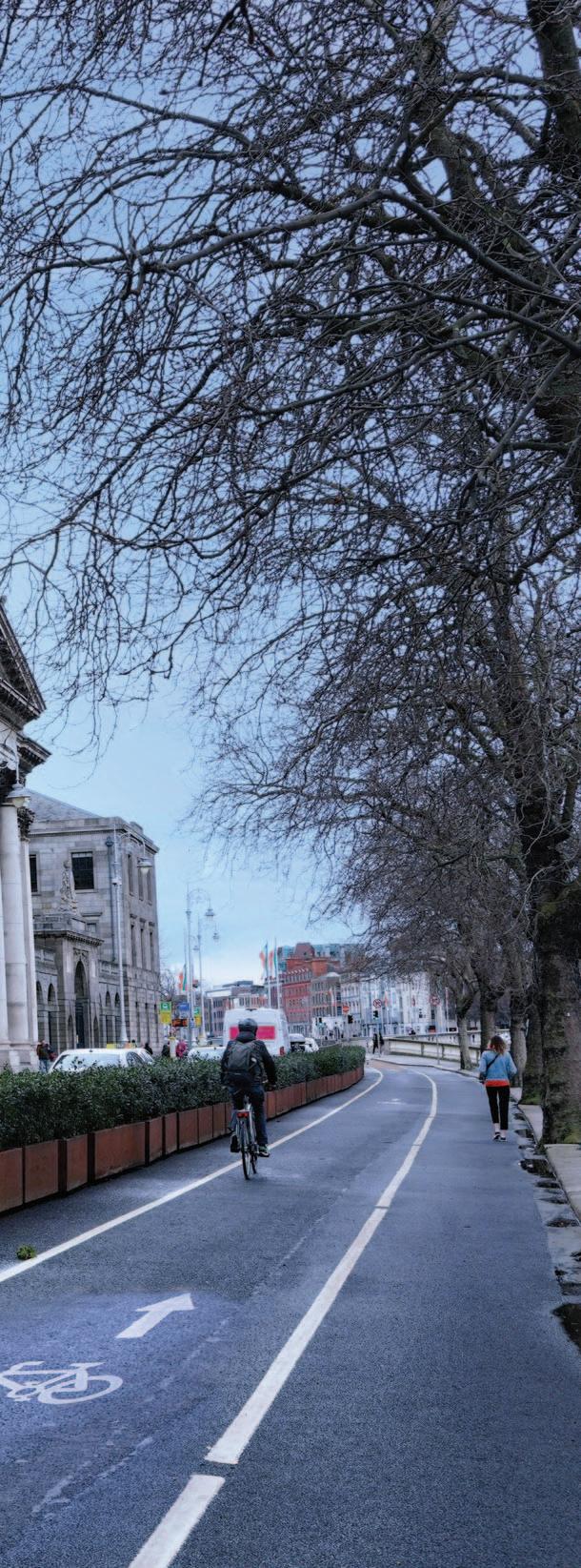

The study highlights enabling infrastructure that would provide an increase in the already relatively successful phenomenon of active travel.
“Dedicated infrastructure that allows cyclists to complete full journeys while feeling safe increases cycling, particularly among women and older people who are otherwise less likely to cycle,” the ESRI states.
“Cycle lanes that are segregated from other traffic, painted and are given priority by lights at intersections boost real and perceived safety for both cyclists and pedestrians. These benefits are greater when initiatives are accompanied by traffic calming measures, such as reduced speed limits and raised crossings at intersections.”
Asserting that the impact of active travel schemes is “often more positive than people expect”, the study, undertaken by the ESRI’s Behavioural Research Unit, reviews international evidence on the effects of infrastructure changes designed to promote cycling and walking, including the impact on communities and public opinion.
The ESRI further finds that there is strong international evidence that improving active travel facilities boosts rates of cycling and walking.
“Knock-on effects on local food and retail businesses tend to be positive or neutral, while such schemes can also reduce traffic congestion.”
Despite benefits of reduced emissions, better air quality, and improved public health, the ESRI is cognisant of the fact that proposals to alter existing infrastructure to facilitate active travel frequently face opposition from communities, usually based on negative expectations about the effects on businesses and traffic.
The report authors state that active travel infrastructure “has large potential to decrease car dependency and promote healthier, more sustainable communities”.
“Planning and design decisions determine the scale of effectiveness. Achieving the goal of behaviour change is made more likely by incorporating evidence from psychology and other behavioural sciences,” they state.
On the phenomenon of negativity towards the construction or promotion of new active travel infrastructure, the review points to multiple psychological biases that it asserts “may hinder support”, including what it describes as “status quo bias” i.e. the preference for things to remain the same even if change is proven to be beneficial.
The report further cites “primary effects” i.e. overweighting of the first piece of information based on who it comes from rather than what it contains; “messenger effects” i.e. evaluations of information based on who it comes from rather than what it contains; and “collective illusion”, i.e. belief among supporters of schemes that they are in a minority, as possible explanations for the failure to maximise public support for schemes likely to be beneficial.
The report asserts that there is “strong evidence” that connectivity, proximity, and safety should be “prioritised over other design elements”. “Segregated, painted, one-way cycle lanes, dedicated priority lights at intersections, advance stop lines, traffic calming measures and direct routes accessible only by walkers and cyclists are ways to maximise perceived and objective safety – and in turn usage,” the report states.
In light of this, the ESRI authors called for the early planning new active travel schemes which they say “needs to begin with early communication undertaken within an open and fair consultation”.
“Ideally, messages should aim to challenge status quo bias and would aim to help local citizens to make up their minds about the benefits and disadvantages of change based on accurate perceptions and expectations. In particular, impacts on traffic, local businesses, and safety should be addressed.”
The study, formally titled, Active travel infrastructure design and implementation: Insights from behavioural science, was authored by Shane Timmons, senior research officer with the ESRI’s Behavioural Research Unit, and was commissioned by the National Transport Authority and Fingal County Council.
Speaking following the publication of the report, Timmons said: “In multiple countries, research finds that people become more positive about changes once they are implemented. Open and fair consultations with communities to address concerns about traffic, local businesses and safety are helpful.

As Ireland grapples with a surge in road fatalities, the Road Safety Authority (RSA) has intensified its efforts to curb dangerous driving behaviours and promote road safety through a series of targeted campaigns and collaborations.
By 29 May 2024, 79 lives have been tragically lost on Irish roads, an increase of 8 lives lost compared to the same period last year. In response to this, and with additional funding, the RSA has increased its advertising and education awareness initiatives over the last six months to help reverse this alarming trend.
In recent years, the RSA has evolved its advertising strategy to be more targeted, more focused, serving the right message to the right audience at the right time. This means that there is
less wastage and not everyone will see all the messages all the time.
Already this year, the RSA ran a number of awareness campaigns that targeted the young male cohort. These include a late-night audio campaign delivering messaging on speeding, phones and driving, seatbelt wearing, driving under the influence of drink and drugs, at a time when road fatalities had increased. The activity ran in conjunction with a social media campaign with the same messages and allowed for upweighting in counties that
has seen an increased in road fatalities. A campaign that provided weekly/monthly road safety figures also aired across national radio in a bid to remind road users of the increase in fatalities and serious injuries.
The third phase of its Vision Zero campaign aired earlier this year, urging all road users to adopt safer practices to protect themselves and others. It emphasised the need to work together and also the changes each road user can make to help Ireland achieve Vision Zero.
A new campaign advocating for a 30km/h speed limit in urban areas also aired this year. The campaign was a strategic measure backed by substantial evidence showing its effectiveness in reducing traffic fatalities. Lower speed limits make streets safer and more pleasant for children and adults alike, encouraging more active travel such as walking and cycling. The RSA also collaborated with Joe.ie featuring vox pops at Technological University Dublin and interactive activities like trying on beer goggles to simulate the effects of alcohol on driving. The RSA’s Driver Attitudes and Behaviour Survey 2023 highlighted a troubling trend: one in four motorists think it is acceptable to drive short distances after drinking.
A new SAY IT campaign was developed with Urban Media, which ran across radio, print and social media encouraging the public to Don’t Just Think It Say It, if you are concerned about a loved one’s driving behaviour.
Professional cyclist, Imogen Cotter, allowed her experience to be the focus of a safe cycling campaign, which reminded drivers of the safe passing distance when over taking cyclists. This initiative was driven by alarming statistics from the RSA’s report on cyclist fatalities and injuries, revealing that the majority of serious injuries occur in collisions with cars or light goods vehicles. Imogen Cotter, who survived a severe cycling collision in 2022, has been a poignant advocate for this cause. Her campaign, which aired on TV and digital platforms, reminded motorists to share the roads responsibly. This campaign will appear in sporting finals throughout the summer months as part of a significant upweight of road safety advertising awareness initiatives.
Last month the RSA launched a highprofile campaign to educate the public about new regulations for e-scooters. This multi-channel campaign, which included TV, radio, social media, and out-of-home advertising, aimed to integrate e-scooter safety into the broader road safety narrative. The campaign’s creative approach, set in an office environment with characters representing different vehicles, highlighted the main rules for e-scooter use. By familiarising the public with these regulations, the RSA aims to ensure the safe coexistence of escooters with other road users.
In April 2024, the RSA held its inaugural

Youth Forum which consists of 20 young people between the ages of 12 and 25. It aims to start a conversation and provide a safe space for young people to discuss their common road safety concerns and influence decision making.
Coinciding with the subsequent May Bank Holiday, the RSA introduced the Time to Talk campaign, a poignant initiative urging individuals to discuss safe driving practices with their loved ones. Featuring stark imagery of a hearse and funeral notices, the campaign aimed to evoke the emotional weight of losing someone to road trauma. This campaign highlighted the devastating impact of dangerous driving habits and encouraged families to engage in honest conversations about road safety with their loved ones. With the support of additional funding, there are a number of new mass media campaigns, focusing on dangerous driver behaviours that are in the pipeline at the moment and will air later this year. These include new mass media campaigns focusing on disqualified driving, drink and drug driving and a speed. A significant upweight of advertising around sporting activities will be evident throughout the summer months. An increased RSA presence at
festivals and local events can also be expected in the coming months. This additional support also allows for a refresh of some of the RSA education resources in time for the new school term.
The RSA’s comprehensive road safety activity in 2024 reflect a determined effort to address the rising fatalities on Irish roads. By promoting safer driving behaviours, advocating for lower speed limits, and raising awareness about the importance of vulnerable road user safety, being present on the ground at community events, the RSA is working tirelessly to make Ireland’s roads safer for everyone. These initiatives, supported by strong collaborations with partner organisations and informed by recent research, are crucial steps in reversing the troubling trend of road deaths and serious injuries. The RSA remains committed to its vision of zero fatalities on Irish roads, but it cannot be achieved alone, road safety is a collective responsibility and we all must play our part in creating safer roads.
W: www.rsa.ie


The National Cycle Network (NCN) plan proposes a cycle network of approximately 3,500km, connecting more than 200 settlements and 2.8 million people nationally.
Developed in the context of national policies which recognise Ireland’s declaration of a climate emergency in 2019, the NCN plan aims to facilitate increased cycling and walking amongst leisure users, tourists, and commuters, as well as alleviate greenhouse gas emissions and facilitate implementing the commitments under the Climate Action and Low Carbon Development (Amendment) Act 2021.
Furthermore, Climate Action Plan 2024 highlights the need to facilitate a 50 per cent increase in daily walking and cycling journeys as part of the transport sector’s decarbonisation pathway.
Produced on behalf of the Department of Transport (DoT) and Transport Infrastructure Ireland (TII) with the support of AECOM Ltd, the NCN plan aims to “link cities and towns of over 5,000 people with a safe, connected and inviting cycle network”.
On a broader scale, the plan also has a vision to: “Develop a safe, connected, and inviting cycle network between urban areas and key destinations to achieve accessible, sustainable, and high-quality routes that will help reduce the carbon impact of transport and promote a healthy and inclusive society.”
To achieve the overall vision, the development of the plan was informed by an assessment of the existing and planned cycle of networks, an analysis of population densities, and likely travel demand.
The NCN plan aims to ensure that 80 per cent of households and 89 per cent of jobs are located within five kilometres of the network. Furthermore, the plan aims to provide “an excellent level of connectivity


nationally”. With 400 kilometres of the NCN currently in use as existing greenways and cycling infrastructure, and over 900 kilometres included in the National and Regional Greenways Programme, the remaining 2,200 kilometres will require new infrastructure outside of current programmes and funding.
As well as contributing to Ireland’s commitments to sustainability and decarbonisation, the NCN plan states that successful implementation will provide many benefits for cyclists and communities, including:
• ensuring delivery of a high-quality cycle network which will promote safety, comfort, and increased participation in cycling;
• improving sustainable connectivity nationally through providing links with other networks such as CycleConnects, EuroVelo, and networks in the North;
• supporting both urban and rural economies through increased leisure and tourism cycling;
• improving public health through the well-documented benefits of active travel;
• guiding how local authorities prioritise investment in cycling infrastructure nationally; and
• making use of existing infrastructure wherever possible including greenways, road infrastructure and declassified roads where safe and appropriate cycle experiences can be achieved.
Focusing on the design principles for the NCN, the defining characteristic of the preferred infrastructure is that routes are all segregated, thus “allowing cyclists to travel in their own space, away from road vehicles with a higher level of safety and comfort”.
The NCN will be planned and delivered as a single programme, rather than a series of inter-related projects. This method aims to ensure an integrated approach to delivery. The focus of the delivery programme will be on providing a coherent network, with regional balance.
An indicative cost estimate for the delivery of the NCN is between €1.49 billion and €1.91 billion, depending on the infrastructure types used across the network.
Approximately €30 million will be required to upgrade the existing infrastructure to the NCN design standard, including additional signage. The cost of planned greenways is €940 million while the remaining infrastructure would cost between €520 million and €940 million, depending on the type of infrastructure required.
The aim for delivery of the NCN is due to be across three phases from 2023 to 2040. To achieve this target, various corridors have been assigned to each delivery phase based on the results of a multicriteria assessment, which considered a range of factors, including “potential demand along each corridor, corridor length, network coherence, safety, and social benefits”.
The NCN plan states that “environmental considerations and evaluation were integral to the development of the NCN Plan”. Strategic Environmental Assessment (SEA) and Appropriate Assessment (AA) will aim to guide development to achieve its ambitions.
Commenting on the NCN plan, Minister for Transport Eamon Ryan TD stated: “This national cycling network will act as a core spine, connecting towns, cities, and destinations across the country with safe, segregated cycling infrastructure wherever feasible. I think this will really help to encourage cycling confidence and in turn the number of trips taken by both walking and cycling amongst locals, leisure users, and tourists alike.”
Peter Walsh, Chief Executive of Transport Infrastructure Ireland, said: “The national cycle network will open in phases throughout the country in the coming years. It will provide a safe and enjoyable way for people to travel, and it will support a more sustainable future for the country.”


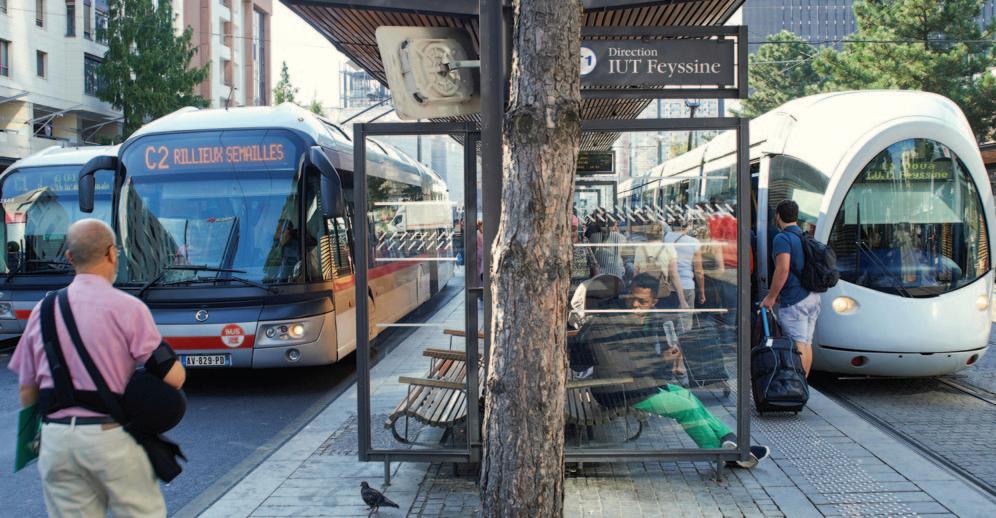
Tram systems are experiencing a remarkable resurgence in the 21st century.
That is because they are indispensable to multimodal transport networks, seamlessly integrating with a city’s metro, bus, and train systems. This integration not only expands travel options but also enhances connectivity between neighbourhoods, delivering substantial social and economic value.
At Keolis, we excel in managing and maintaining multimodal transport networks, with trams playing a central part in this work, ensuring we can offer seamless passenger experiences. Our expertise allows us to design tailored mobility solutions that meet the specific needs and financial scope of each town, city, or region – providing a smart solution to meet the demands of modern cities.
Our unparalleled success in supporting the development, operations, and maintenance of these networks is evident in cities like Lyon, Bordeaux, Dijon, and Lille in France; Newcastle, Australia; and both Manchester and Nottingham in England, to name a few. With urban populations on the rise, connectivity has never been more crucial. In 2023, cities were home to 57 per cent of an average country’s population, and by 2050, it is
projected that 70 per cent of the world’s population will reside in cities. This upward trend underscores the importance of enhancing urban connectivity to accommodate growing populations, making forward-thinking planning essential for future social prosperity.
So where to begin? Keolis leads the way in planning and developing integrated networks, with trams at their core.
Keolis gains a deep understanding of evolving transport needs through its Keoscopie mobility think tank. Keoscopie provides valuable insights into current lifestyles, helping us create next-generation mobility solutions. This knowledge is further enhanced by data collected by Hove, a Keolis digital company. Hove produces intelligence that our teams use to innovate and develop attractive, integrated transport solutions.
At Keolis we have also established a Centre of Excellence for trams, which connects our global experts, in support of PTAs at every stage of a project’s lifecycle. This partnership ensures continuous improvement in our tram systems, helping us maximise their integration within our networks.
The tram’s appeal lies in its comfort, capacity, and user-friendly nature, serving as a handy option for those looking to transition effortlessly to soft modes of getting around like bikes or scooters. This versatility consistently appeals and draws in new customers.
To fully capitalise on the system’s popularity, Keolis has worked closely with PTAs to ensure that their tram operations provide a complement to local bus networks – even where it may only be a single mode provider. This is crucial because certain bus routes are able to mirror tram standards in terms of frequency and quality and provide critical connectivity to wider areas beyond the city’s limits.
This coordination means riders can easily switch between modes and provides an opportunity for better social cohesion between city and suburbs.
For instance, trams are ideal for connecting outlying municipalities located between 15 and 20km from the city centre through fast lines in less dense areas, as seen with Keolis’ work

in Manchester and Dijon. From these tram stops hyper-local buses can be teed up to take passengers even further to their desired destination.
Our operations of the tram network in Dijon, for example, is fully interconnected with local bus networks and feeder systems, making most neighbourhoods accessible.
We have also implemented contactless payment terminals on all of Dijon’s trams to enhance the passenger experience.
With the introduction of a Mobility as a Service (MaaS) app, Keolis worked with the transport authority to enhance the passenger experience even further by integrating all public transport options in Greater Dijon, including the tram, into a single platform. This app facilitates bookings, route searches, and real-time timetable updates. Additionally, the Bouquet Libertés, which Keolis launched in September 2021, allows users to combine their transport ticketsincluding buses, trams and car parking –and incentivises multimodal travel.
These initiatives distinguish Keolis, working in collaboration with its PTAs, as a leader in creating attractive, easy-touse integrated networks, which is crucial given burgeoning urban populations both now and in the future.
Alternatively, Keolis seamlessly integrates tram networks with metro and urban train systems to maximise their

potential. Take Paris, for example, where our Ile-de-France Tramway Line 9 (T9) links the Porte de Choisy Paris Metro station to Orly city centre, forming part of a comprehensive transit network. This light rail system operated by Keolis is the world’s second busiest after Tokyo, offering connections to suburban train lines, metro lines, bus routes and the Grand Paris Express rapid transit lines.
More recently, Keolis’ tram operations in Bordeaux were extended by a 5km branch line on Route A to reach the city’s Mérignac Airport. With approximately 6,500 daily passengers, the tram now offers essential connectivity not just to buses, metros and trains, but also to planes, facilitating convenient travel for both tourists and businesspeople.
Keolis’ efforts to increase the ease of movement of local populations yields secondary economic benefits for PTAs and the communities they serve by fostering business confidence and expediting inward funding cycles.
We know at Keolis there is no one-sizefits-all solution for how to operate a multimodal transport network, but looking to international best practice, learnings and tram systems is a good place to start.
www.keolis.com

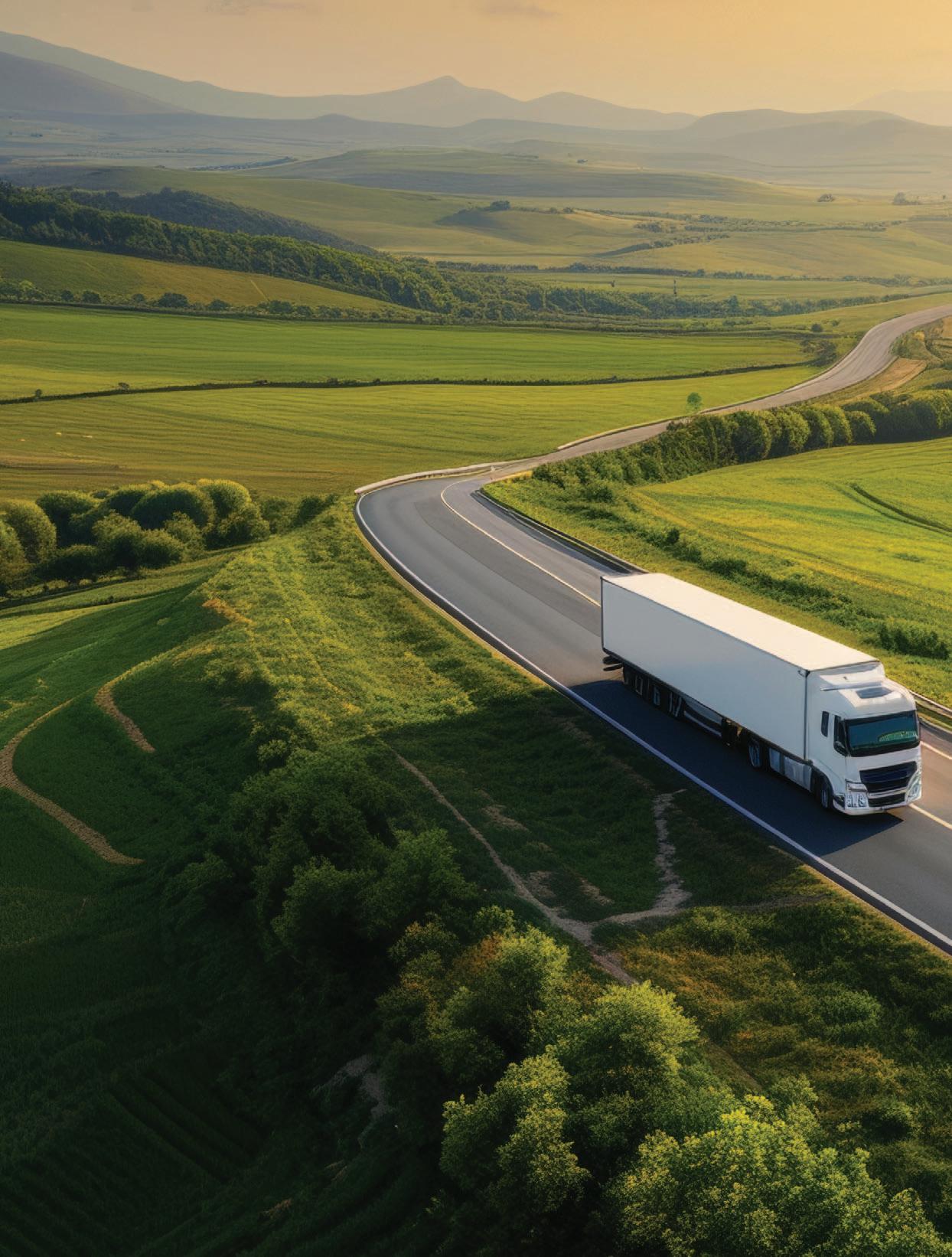
2023 saw the establishment of the Road Freight Forum, the commissioning of a data quality study, and active advocacy for stricter EU emission standards under the auspices of Ireland’s Road Haulage Strategy 2022 to 2031.
Published in January 2024, the first progress report of the Road Haulage Strategy states that one of the initial actions was the establishment of a Road Freight Forum.
Including representatives from various government departments, agencies, and industry stakeholders such as the National Transport Authority (NTA), Road Safety Authority (RSA), Transport Infrastructure Ireland (TII), Freight Transport Association Ireland (FTAI), and the Irish Road Haulage Association (IRHA), the forum convened four times in 2023, with the last meeting before publication of the review held in January 2024.
Furthermore, the Department of Transport commissioned a study on data availability and quality which aims to identify data gaps, benchmark Ireland’s data against international standards, and suggest improvements. This report was published in May 2024.
The progress report outlines that regarding EU regulations on heavy-duty vehicle (HDV) emissions, Ireland supported the European Commission’s proposals for stricter limits on non-CO2 emissions, such as NOx and particulate matter.
Additionally, Ireland advocated for maintaining the European Commission’s CO2 emissions reduction targets for HDVs.
In line with environmental goals, the strategy includes the development of the National Hydrogen Strategy, considering hydrogen’s role in decarbonising heavy goods road freight. This is complemented by ongoing work by the Zero Emission Vehicles Ireland (ZEVI) office, focusing on infrastructure and energy requirements to facilitate electric heavy goods vehicles (HGVs).
On infrastructure, key actions undertaken in 2023 include ensuring that the National Roads 2040 strategy addresses the needs of the haulage and road freight sector and mapping existing infrastructure to identify priority projects. Additionally, the All-Island Strategic Rail Review aims to explore the strategic use of the rail network for freight.
The strategy also emphasises integrating the road freight sector’s importance into all transport strategy documents, including the National Ports Policy and the review of the National Aviation Policy.
A notable initiative to support hauliers is the review and potential reform of the driver CPC (Certificate of Professional Competence) programme to ensure its relevance and usefulness. Additionally, a new IT system for processing road transport operator licenses is being developed to enhance digital and customer service capabilities, and due to go live Q3 2024.
The strategy also addresses the potential for license exchange agreements with North Macedonia and Argentina, with work progressing on drafting memoranda of understanding and relevant legislation. Furthermore, the progress report states that Ireland has initiated the negotiation process with Bosnia and Herzegovina for similar agreements.
The Logistics and Supply Chain Skills Group (LSCSG) has also organised the first Logistics and Supply Chain Skills Week in 2023 and a second early 2024.
Published in December 2022, Ireland’s Road Haulage Strategy 2022-2031 focuses on aiming to generate efficiencies, improve standards, as well as help create secure employment and
assist the sector to move to a lowcarbon future.
The strategy sets out measures and supporting policies needed to deliver on these objectives, in particular for decarbonisation and in developing the skills base to ensure the long-term viability of the industry.
For 2024, key priorities include completing the procurement process for national standards for eco-driving, advancing feasibility studies for freight consolidation centres, and continuing the work on the National En-Route Electric Vehicle Charging Network Plan. Monitoring of all strategy actions will continue through regular meetings of the Road Freight Forum.
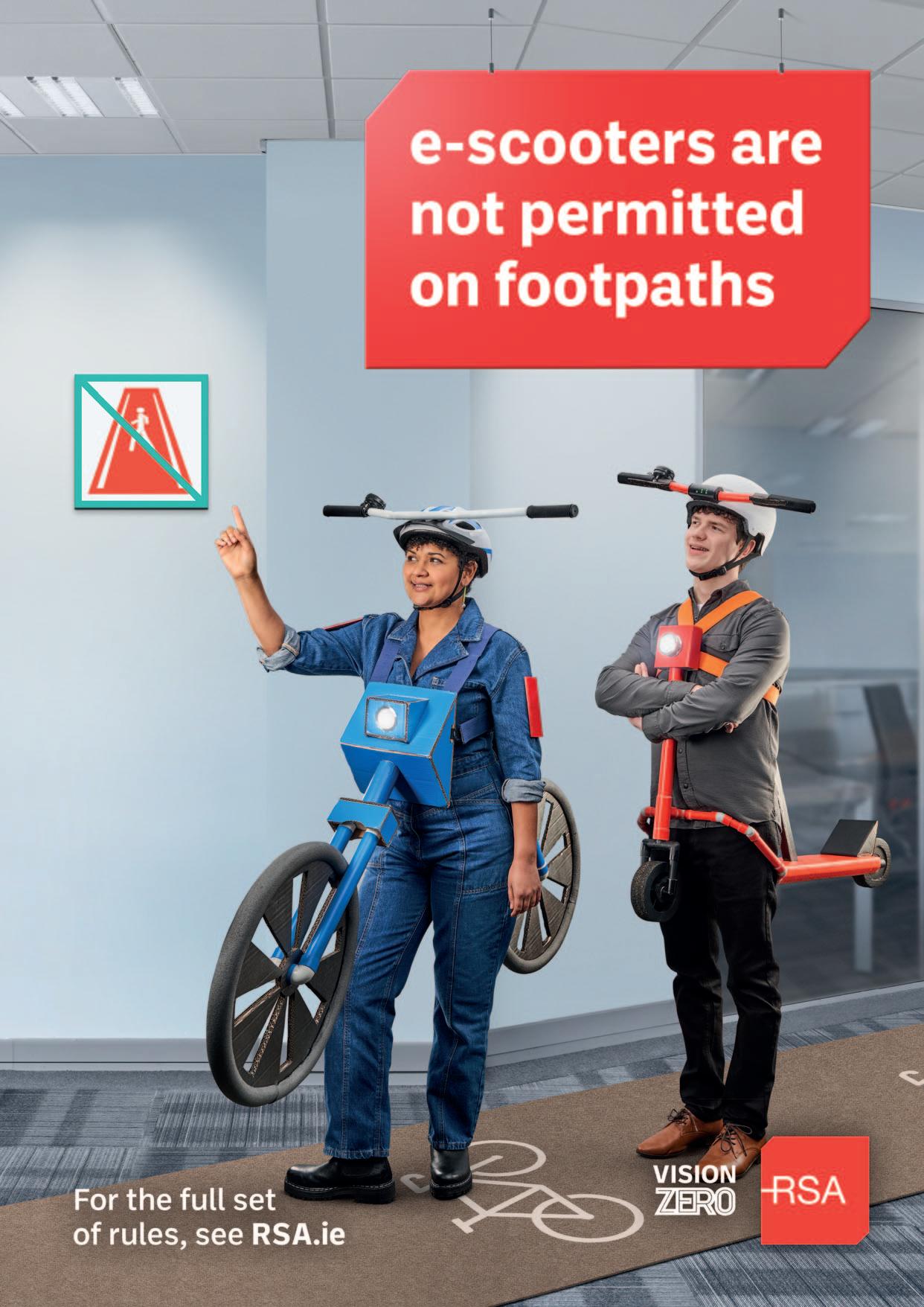

2023 was a transformative year for Bus Éireann as we reported a recordbreaking 107 million passenger journeys across all services. This remarkable milestone, marking a 19.5 per cent increase from the previous year, not only signifies sustained growth but also reflects the resounding success of our Destination 2023 strategy, writes Stephen Kent, CEO of Bus Éireann.
For the first time, we surpassed the 100 million passenger journey mark, a testament to our unwavering commitment to excellence.
Under the Destination 2023 strategy, we focused on providing a best-in-class user experience achieving a customer satisfaction score of 93 per cent, surpassing our strategic target of 90 per cent. Our dedication to enhancing passenger journeys led to a 28 per cent increase over the five-year period,
showcasing our ability to deliver safe, reliable, and punctual services across the board.
Looking towards the future, our focus remains steadfast on sustainability and innovation. Through future-focused “forever” projects, we are poised to deliver over 2.6 million emission-free kilometres per year, supporting our mission to connect people and communities and helping to make life better.
Building on this foundation of success, we aim in our new corporate strategy, Horizon 28 – Our Vision for Green Growth, to double passenger journeys while managing growth sustainably. Central to this effort are the close partnerships and collaborations we have fostered with stakeholders and partners, including the National Transport Authority (NTA), CIÉ, the Department of Transport, and the Department of Education.
Early in 2023, we launched the first project under the Government’s Pathfinder Programme, the first allelectric town bus service in Athlone, eliminating over 400,000kg of annual tailpipe CO2 emissions. Building on that success, we launched in April this year the first regional city electric bus service in Limerick. This service represents a monumental shift towards a cleaner, greener future, with over 2.1 million emission-free kilometres projected for the city per year.
These landmark investments into the future of public transport infrastructure would not be possible without the support of the NTA. Their collaboration has been instrumental in propelling our electrification efforts forward.
In line with evolving sustainability reporting requirements, we are preparing to report under the Corporate Sustainability Reporting Directive (CSRD) in 2025, while continuing to align with international frameworks such as the Carbon Disclosures Project and the Task Force on Climate-related Financial Disclosures. We are also committed to social responsibility, with clear improvement targets in gender equality, wellbeing, diversity, and inclusion.
As Ireland’s national bus company, we proudly operate the most extensive public transport network in the nation. Our recent success in winning an open market tender for services on the Eastern Commuter Corridor and Carlow Town underscores our commitment to expanding our reach and impact. We are particularly excited to have launched the first-ever town bus service in Carlow and its surrounding areas, a testament to our dedication to serving communities where transportation needs are paramount.
Ensuring our services are accessible to all, we have introduced a Travel Assistance Scheme in Cork, Limerick, Galway, and Waterford which has been hugely successful. I am deeply proud of the work of our travel assistants who have supported over 1,000 passengers so far in undertaking their journey with confidence.
The School Transport Scheme which Bus Éireann operates on behalf of the Department of Education, already the largest such scheme in Europe, is experiencing unprecedented growth. With the Department's recent
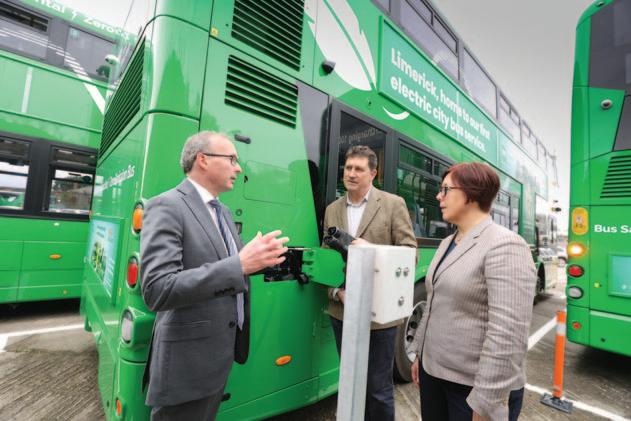
announcement to expand access to an additional 100,000 children by 2030, we anticipate continued growth in demand. Each school day, the scheme oversees the transport of over 162,500 children, our nation’s most precious resource, safeguarding their future by ensuring reliable access to quality education.
Our continued enhancements of services under the Connecting Ireland Rural Mobility Plan and initiatives such as Bus Connects will lead to significant expansion of the network for the people of Ireland. Working in strong partnership with the NTA, we will provide greater regional and urban connectivity while delivering on our Climate Action Plan goals.
In 2023 alone, we undertook over 80 timetable reviews in conjunction with the NTA. These reviews were complemented by the introduction of 12 enhanced routes and services as part of Connecting Ireland. This resulted in an additional 2.1 million road passenger kilometres, reflecting the growing demand for our services and the effectiveness of our efforts.
I am optimistic about the future for Bus Éireann, with substantial investments planned for the coming years under BusConnects and Connecting Ireland. I also recognise the significant effort needed to achieve our ambitious goals.
We are determined to improve gender balance among our employees, to better reflect the customers we serve. Since 2022 the overall number of female
employees has increased as we work to double female participation to a fifth of all employees by 2030. Concurrently, we aim to increase fivefold the number of female supervisors to 10 per cent. We must do this by recruiting more women drivers and mechanics, supporting their growth in the company to supervisor level and beyond.
Successful recruitment of drivers and staff in a full employment economy will be key to delivering on our targets for the years to come. Over seven of 10 staff at Bus Éireann say it is a great place to work and I am committed to building on that employee engagement.
Our latest strategy sets out not only our potential for the next five years, but crucially the principles by which we achieve our goals. I am confident that we can continue to operate to the high standard of customer satisfaction that we hold ourselves to, while growing access to our services. For Bus Éireann, and the people of Ireland, success is on the horizon.
T: 01 703 3446
E: info@buseireann.ie
W: buseireann.ie


As part of the Regional Airport Programme 2021-2025, the Government has increased funding for regional airports by €5.6 million.
On 25 April 2025, Minister of State at the Department of Transport, Jack Chambers TD, announced combined funding of over €5.6 million to support eligible regional airports in Donegal, Kerry, and Ireland West (Knock).
The other regional airports in Sligo and Waterford were not granted funding as they do not have any active routes.
Post-Covid, the aviation sector has rallied in Ireland, with close to record passenger numbers in Dublin Airport (which is subject to a passenger cap), increases recorded in Shannon, Cork, and the two Belfast airports, with Knock Airport experiencing a record year in 2023.
However, the regional airport sector in Ireland – north and south – has largely failed to recover from the crash caused by the decline in passenger traffic in the 2008 financial crisis.
This has resulted in the closure of Galway Airport, which in 2008 offered 16 routes and served over 300,000 passengers. The airports in Waterford and Sligo similarly both served zero passengers in 2023. In the North, the City of Derry Airport continued its stagnancy with a marginal decline in traffic recorded in 2023.
The airports in Kerry and Knock currently handle international traffic, and even the domestic route between Kerry and Dublin is operated on a commercial basis without government subvention. Waterford Airport is also likely to expand its capacity to be able to handle large jets such as the Boeing 737 and Airbus A320.
However, the regional aviation sector has never recovered from the post2008 downturn, and this remains likely to largely remain the case, as is necessary if the transport sector is to
play its part in enabling the Government to meet its Climate Action Plan targets for emissions reductions.
Speaking at Donegal Airport, where he announced the funding grant, Minister of State Chambers said: “This funding represents significant investment in our regional airports. Among the 32 projects being supported this year are an aerodrome ground lighting project here at Donegal Airport.
“While many of the projects being supported have environmental aspects to them, ten of the projects approved for funding, amounting to €1.2 million, have a fundamental sustainability focus. These include carbon reduction plans here at Donegal and at Ireland West [Knock] Airport. Other projects include the upgrade to electric vehicles at Kerry Airport and Ireland West Airport.”


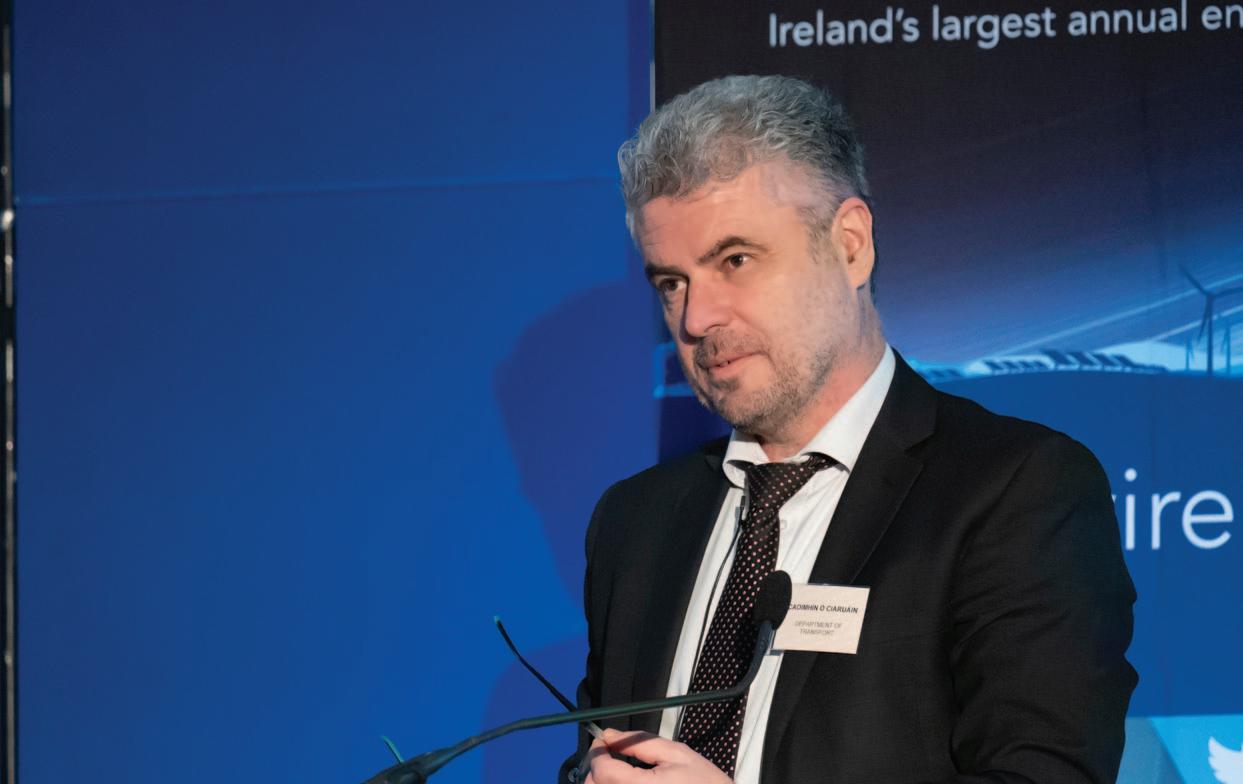
and EU/International at the Department of Transport discusses Ireland’s progress in decarbonising transport and the implication of the EU’s Alternative Fuels Infrastructure Regulation (AFIR).
Ó Ciaruáin believes that the scale of transformation is so enormous that it will only been achieved by aggressively pursuing policy actions across the avoid, shift, and improve approach to the decarbonisation of transport.
Ireland’s climate ambitions are heavily reliant on the co-dependent decarbonisation of energy and transport, sectors which the Assistant Secretary highlights will do the “heavy lifting”, both nationally and in the context of the European Green Deal.
National climate targets require a 50 per cent reduction in transport emissions and a 75 per cent reduction in emissions from electricity by 2030. Outlining the scale of the challenge in meeting this ambition, Ó Ciaruáin points out that currently, fossil fuels represent 95 per cent of Ireland’s fuel mix in transport.
Analysis by the SEAI shows that in 2022, the transport sector emitted 14.5 MtCO2eq, equating to 40 per cent of Ireland’s total energy-related CO2 emissions, including international aviation. The sectoral emissions ceilings have established a 6 MtCO2eq ceiling for transport for 2030.
Breaking down the avoid, shift, improve approach to transport decarbonisation to date, Ó Ciaruáin says that progress has been achieved.
He highlights that the avoid approach –reducing or avoiding the need to travel – will be the most challenging but likely most transformative measure, with benefits that go well beyond carbon reduction. In March 2024, the Government published a new draft demand management strategy which provides a firm policy direction and a suite of options, such as road space
reallocation, progressive taxation, freight efficiency, or behavioural incentives, that can be taken at national, regional, and local levels to bring about the systems changed needed.
As expected, the co-dependency with the decarbonisation of energy lies mostly within the shift and improve paradigms, where the benefits of a shift to sustainable modes of transport and active travel modes are already being seen, particularly around public transport. In 2023, patronage of public transport had risen by 24 per cent on the previous year and under the improve measure, there are advances on the electrification of the fleet and the options for increased blending of biofuels.
Ó Ciaruáin summarises: “The first two carbon budget reduction targets will
lean heavily on electrification, biofuel blending, and alternative fuels to do the heavy lifting, however, beyond that, I think we are looking at a much wider transformation of how we travel.”
The Assistant Secretary explains that progress to date has been driven by a carrot-and-stick approach. Citing one of the most generous sets of incentives for EV take up across Europe as an example of the carrot, he explains that the complex regulatory landscape also requires a stick approach, and has, for example, driven investment and planning in the delivery of charging infrastructure.
Highlighting the significant evolution of the policy landscape in the last decade, Ó Ciaruáin points to the Renewable Transport Fuels Policy Statement 202325 as the key national policy lever for the increased supply of alternative fuels within the transport system.
The statement provides a framework towards meeting targets set out in the Climate Action Plan, such as at least B20 (biodiesel equivalent) in diesel and E10 (ethanol) in petrol by 2030 (with an interim B12/E10 by 2025 target), and European obligations for renewable energy supply for use in transport.
“The level of ambition here is significant. It is the invisible piece of what we do in terms of the Renewable Transport Fuel Obligation (RTFO), but it is also one of the most effective ways of delivering carbon abatement in the transport sector and we depend quite heavily on it.”
Similarly, sub-targets exist for the supply of renewable fuels from nonbiological origins and advanced biofuels and biogases. Separately, obligations are in place for the maritime and aviation sectors. For land transport, the shift towards alternative fuels is being accelerated at EU level through regulations banning the sale of fossil fuel cars and vans from 2035, and the recently adopted phase-out of heavy good vehicles by 2040.
From April 2024, the Alternative Fuels Infrastructure Regulation (AFIR) was applicable and sets a minimum set of mandatory infrastructure requirements for alternative fuels across the TransEuropean Transport Network (TEN-T).
“Within the Department of Transport, and in relation to the development of alternative fuels, given the variety of policies, regulations and supports that
are available, we need to ensure that the kind of policy coherence across the system, but also increasingly across government. We need to work with our colleagues to focus those interventions that deliver the most optimal policy objectives, both nationally and internationally,” he says.
To this end, Ó Ciaruáin explains that the Department has established a working group looking specifically at alternative fuels. The Alternative Fuels for Transport Working Group aims to facilitate greater visibility on policy development and delivery across the transport and energy sectors in relation to the development of alternative fuels in transport.
The group will also coordinate a variety of ongoing actions concerning alternative fuel infrastructure and renewable energy across the transport sub-sectors, land, aviation and maritime, and is expected to produce a report by the end of 2024.
In addition, the Department has established a Sustainable Aviation Fuels (SAF) Task Force to help inform a new national SAF policy roadmap, targeted for delivery by the end of 2024.
Turning to the implications of the Alternative Fuels Infrastructure Regulation (AFIR), Ó Ciaruáin offers a context whereby the regulation’s predecessor was not mandatory and delivery across Europe was “patchy”. As a result, several member states, including Ireland, are playing catch up on what is required.
The objective of the regulation is to set minimum mandatory infrastructure requirements and timeframes, with severe penalties outlined for those who do not deliver on their obligations.
While delivery on the ambitions will be challenging, Ó Ciaruáin acknowledges the “level of certainty” the regulation offers to sectors, markets and the public that projects will be advanced.
In relation to electrification, it is estimated that the first AFIR target for 2025 will require a 300 per cent increase of charging capacity.
“We have to show and be clear that we are pursuing this aggressively in order for that takeup to happen, and people feel confident that they have the public

charging infrastructure available.”
Additionally, AFIR requires significant investment in the hydrogen space over the next decade. A requirement of refuelling stations that can serve both light and heavy-duty vehicles in every urban node on the TEN-T network, at intervals of every 200km on the TEN-T corridor translates into a hydrogen refuelling station in Dublin, Cork, Galway, and Limerick, which are capable of dispensing one tonne of hydrogen per day.
The first deployments of this type of infrastructure are scheduled for 2027, which will be majorly challenging for Ireland. However, the Assistant Secretary points to work under the Shared Island Initiative to progress research and feasibility studies with the Department for the Economy in Northern Ireland, and alignment with the National Hydrogen Strategy, as the groundwork which is being laid for rollout on a larger scale.
The AFIR also sets strict infrastructure development regulations in relation to liquified methane, maritime, and aviation.
The Assistant Secretary summarises: “AFIR targets are hugely challenging, and with infrastructure deployment expected to be ahead of demand in some instances, the ‘build it and they will come’ perspective at EU level is not without significant risk and operational challenges for member states.”
Ireland’s approach to these areas will be set out in the AFIR National Policy Framework. Currently in development, Ireland, along with other member states, must submit a draft National Policy Framework to the European Commission for review by the end of 2024. A final national policy framework must be set by the end of 2025.
A public consultation seeking submissions from wider transport and energy sector stakeholders to inform the development of an updated National Policy Framework for Alternative Fuels Infrastructure in Transport launched in May 2024 and closed on 14 June.
The Department of Transport expects to advance and publish an updated draft policy framework for further consultation in the second half of 2024, with final policy frameworks required to be submitted to the European Commission by 31 December 2025.


Sustainable aviation fuel (SAF) is still at an early stage of development, but between 2025 and 2050, airlines and governments will be legally obliged to ensure that it grows from 2 per cent of minimum share to 70 per cent, as outlined in the REFuelEU aviation initiative.
The main objective of the REFuelEU aviation initiative, as a key part of the EU’s Fit for 55 package, is to “increase both demand for and supply of sustainable aviation fuels (SAF), which have lower CO2 emissions than fossil fuel kerosene, while ensuring a level playing field across the EU air transport market”.
The new legislation aims to put air transport on the trajectory of the EU’s climate targets for 2030 and 2050, as SAF is well-established as one of the key short- and medium-term tools for decarbonising aviation. Currently, the rollout of SAF is being hindered by low supply and prices much higher than prices of fossil fuels.

The new regulation contains six main provisions:
1. aviation fuel suppliers must ensure that all fuel made available to aircraft operators at EU airports contains a minimum share of SAF from 2025 and, from 2030, a minimum share of synthetic fuels, with both shares increasing progressively until 2050. Fuel suppliers will have to incorporate 2 per cent SAF in 2025, 6 per cent in 2030 and 70 per cent in 2050. From 2030, 1.2 per cent of fuels must also be synthetic fuels, rising to 35 per cent in 2050;
2. aircraft operators must ensure that the yearly quantity of aviation fuel uplifted at a given EU airport is at least 90 per cent of the yearly aviation fuel required, to avoid tinkering practices which would bring additional emissions from extra weight;
3. the scope of eligible sustainable aviation fuels and synthetic aviation fuels includes certified biofuels, renewable fuels of non-biological origin (including renewable hydrogen) and recycled carbon aviation fuels complying with the Renewable Energy Directive (RED) sustainability and emissions saving criteria, up to a maximum of 70 per cent, with the exception of biofuels from food and feed crops, as well as low-carbon aviation fuels (including low-carbon hydrogen), which can be used to reach the minimum shares in the respective part of the regulation;
4. rules on the competent authorities, to be designated by the member states to enforce this regulation, and rules on fines;
5. The creation of an EU labelling scheme about environmental performance for aircraft operators using SAF, which will help consumers make informed choices and will promote greener flights; and
6. data collection and reporting obligations for fuel suppliers and aircraft operators enabling to monitor the effects of this regulation on the competitiveness of EU operators and platforms.
The REFuelEU aviation initiative is part of the Fit for 55 package. Presented by the European Commission on 14 July 2021, the package aims to enable the EU to reduce its net greenhouse gas emissions by at least 55 per cent by 2030 compared to 1990 levels and to achieve greenhouse gas emissions neutrality in 2050.
On 2 June 2022, the EU’s Transport, Telecommunications and Energy Council (TTE) reached a general approach to the proposal. Following interinstitutional negotiations between the European Council and the European Parliament (trilogues), the two co-legislators reached a provisional political agreement on the file on 25 April 2023.
Policy actions and the efforts of industry have led to improvements in fuel efficiency over recent years. For instance, the amount of fuel burned per passenger dropped by 24 per cent between 2005 and 2017. However, these environmental benefits have been outpaced by a sustained growth in air traffic, with passengers in 2017 flying on average 60 per cent further than in 2005.
In the EU in 2019, direct emissions from aviation accounted for 3.8 per cent of total CO2 emissions. The aviation sector creates 13.9 per cent of emissions from transport, making it the second biggest source of transport GHG emissions after road transport. If global aviation were a country, it would rank in the top 10 emitters.
Someone flying from Lisbon to New York and back generates roughly the same level of emissions as the average person in the EU does by heating their home for a whole year.
Before the Covid-19 pandemic, the International Civil Aviation Organization (ICAO) forecasted that by 2050 international aviation emissions could triple compared with 2015.
Sustainable aviation fuel (SAF) is a greener jet fuel, the use of which seek to reduce the lifetime emissions of engine burn, acting as a drop-in fuel that can be blended in increasingly high proportions with conventional Jet A1. Widespread use of SAF has the potential to cut aviation’s greenhouse gas emissions by up to 80 per cent compared with traditional jet fuels.
November 2023 saw the first ever example of a transatlantic flight powered by SAF, as a Virgin Atlantic Boeing 787 Dreamliner successfully flew from London Heathrow to New York’s JFK Airport. On the flight, the plane was filled with 50 tonnes of SAF. Two types were used, with 88 per cent derived from waste fats and the rest from the wastes of corn production in the US.
Commercial viability remains a stumbling block for widespread use, but the fact that the technology is proven to be useable and theoretically commercially viable means that, in the long term, the scope for progress is significant.

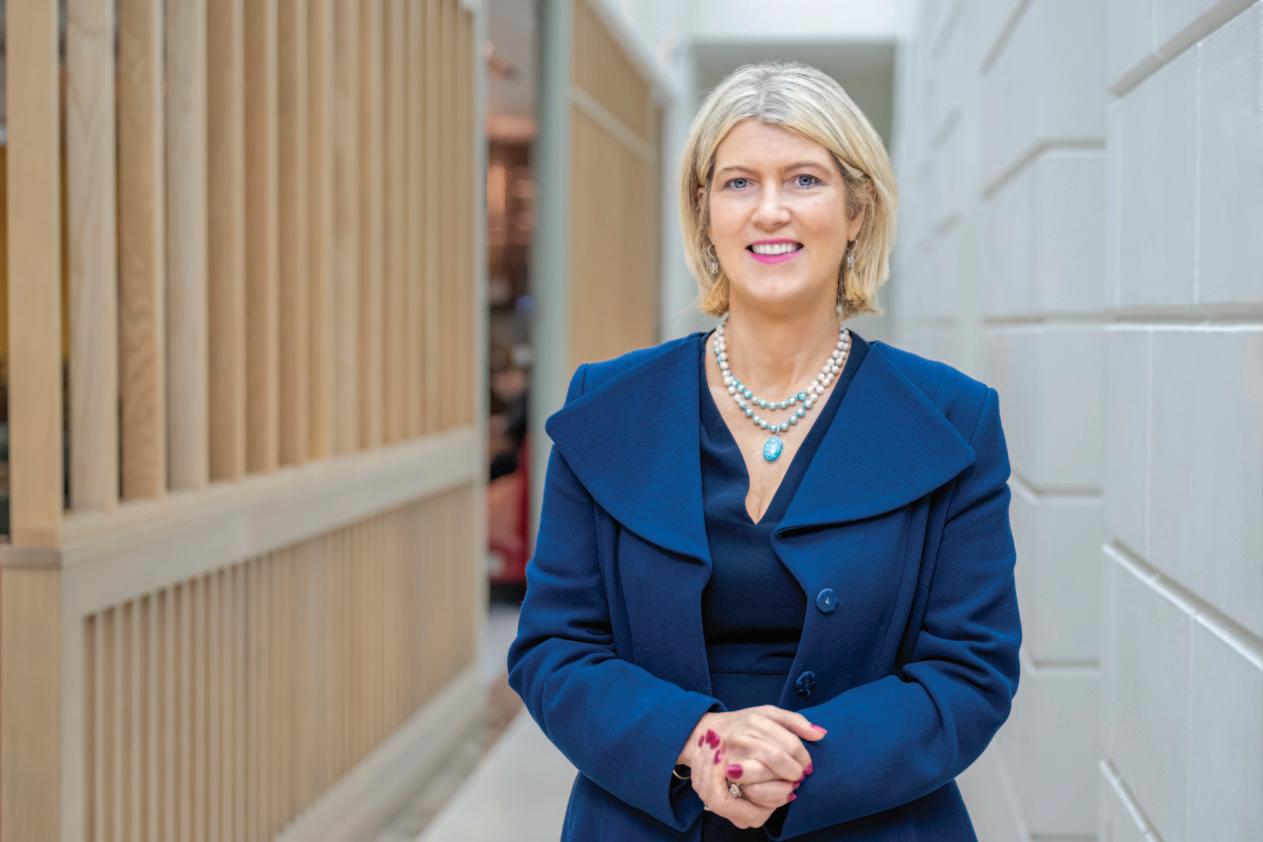
Teresa Fallon, High-Power Infrastructure Lead at Zero Emission Vehicles Ireland (ZEVI) outlines the development of Ireland’s National EV Charging Infrastructure Plan.
Set up in July 2022, ZEVI is a dedicated office within the Department of Transport charged with supporting consumers, the public sector, and businesses to make the switch to zeroemission vehicles.
The office’s work is an ambitious target within Climate Action Plan 2024 to have an expected 30 per cent of the country’s private car fleet switched to electric by 2030. Supplementing this target is an ambition to have 195,000 plug-in EVs on the road by 2025, and a
300 per cent increase in charging capacity in the same timeframe.
Offering an assessment of Ireland’s positive EV progress to date, Fallon points out that there are currently over 114,000 EVs with a plug on Irish roads. Market choice has also increased, with over 31 brands (over 70 models) available, and price points reduced, meaning price parity with internal combustion engines is getting closer. The Alternative Fuels Infrastructure

Regulation (AFIR) mandates the need for 1.3KW of battery electric vehicle charging per vehicle and 0.8KW of charging per plug-in hybrid. To meet these power targets for infrastructure charging for light good vehicles, Ireland will need to increase charging capacity by at least 300 per cent by 2025.
“That is a tall order, especially in a country where we have so much home charging,” says Fallon. “The amount of public charging is a challenge to deliver and effectively means that we need to go from 71MW of charging to 214MW by the end of 2025.”
Also required, as outlined in the draft National Road EV Charging Network Plan, Ireland will need to increase the number of charge points from 2,100 to between 3,200 and 6,210 nationally (depending on need). For light good vehicles, a charging pool is required every 60km on the motorway network, while for heavy-duty vehicles between 1.4MW to 7MW will be required every 60 to 100km.
The Draft Regional and Local EV Charging Network Plan is the second element of the National EV Charging Network Plan and follows the development of the National Road Network EV Charging Plan, which was launched for public consultation in September 2023.
The National Road Network EV Charging Plan is being delivered in close collaboration with TII and ESB to increase EV charging infrastructure on motorways, as well as national primary and secondary roads. Meanwhile, the draft Regional and Local EV Charging Network Plan is being developed in conjunction with local authorities.
ZEVI launched the National En-Route EV Charging Network Plan for Consultation in September 2023, setting out the quantum and frequency of charging power along the major roads network. Fallon explains that extensive international research, alongside detailed modelling, highlighted that simply meeting the requirements of the Alternative Fuel Regulation would fall short of what was needed on Ireland’s national road network.
“Importantly, within our modelling, we looked at the personas who would be using the network and compiled eight categories, resulting in targets for both light-duty and heavy-duty vehicles.”
The draft plan also addresses potential market enablers, such as financial supports, grid applications for heavy-duty vehicles, battery technologies, and a review of planning requirements. In relation to standards, it builds upon the Universal Design Guidelines for Electric Vehicle Charging Infrastructure published at the end of 2023, while also bringing forward measures included in the Alternative Fuel Regulation such as ad-hoc payment, data sharing, and interoperability.
Currently in development, Fallon explains that the priority aim of the Regional and Local EV Charging Network Plan will be a shift from a business-led approach to a demand-led approach beyond 2030.
Currently, local EV charging infrastructure has largely been rolled out through private investment, with some public support. However, there is a recognition of the risk being taken on by businesses because of the absence of a fully formed EV market. As part of the plan, ZEVI will task local authorities to develop their own strategies, transitioning towards a planned-led approach.
“From 2025 we intend to be rolling out plan-led infrastructure, which is not solely based on private investment. Delivery of that infrastructure will also enable is to collect data and gain more certainty as to where infrastructure should be best located, which will enable future delivery to be demand led,” Fallon concludes.

Register today at the early bird rate!
Now in its third year, Digital Marketing Dublin will feature expert speakers from across the spectrum of digital marketing including a focus on targeting specific audiences through tools such as SEO, paid search and email marketing.
#DMDublin will get to the heart of digital planning and strategy. Leading digital marketing experts will examine best practice and achieving results, giving examples of successful campaigns.

• Digital marketing strategy and planning
• Data and analytics
• AI and technologies for digital marketing
• SEO
• Email marketing
• Content marketing
• Paid search advertising
• Influencer marketing
• Social media
• Video • UX
Speakers confirmed

Darragh


Aoife McIlraith



Dr Dónal Mulligan

